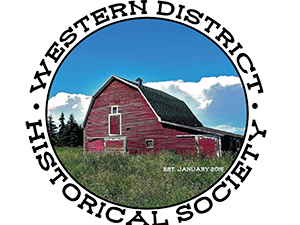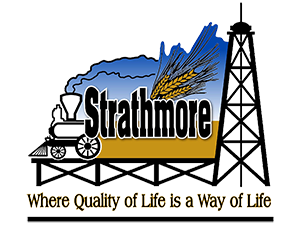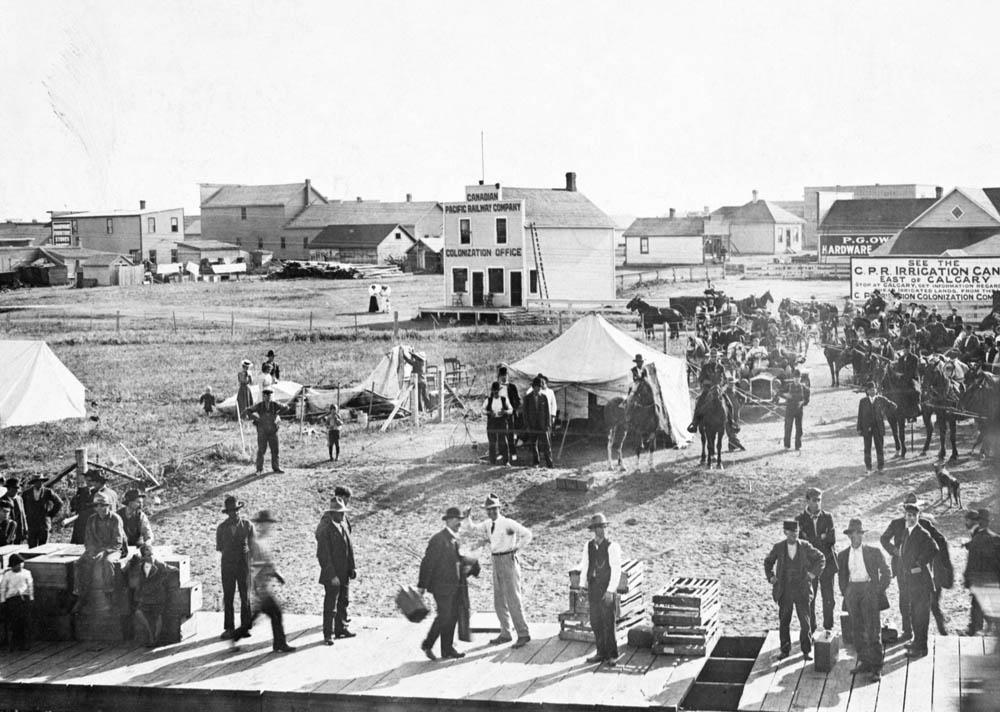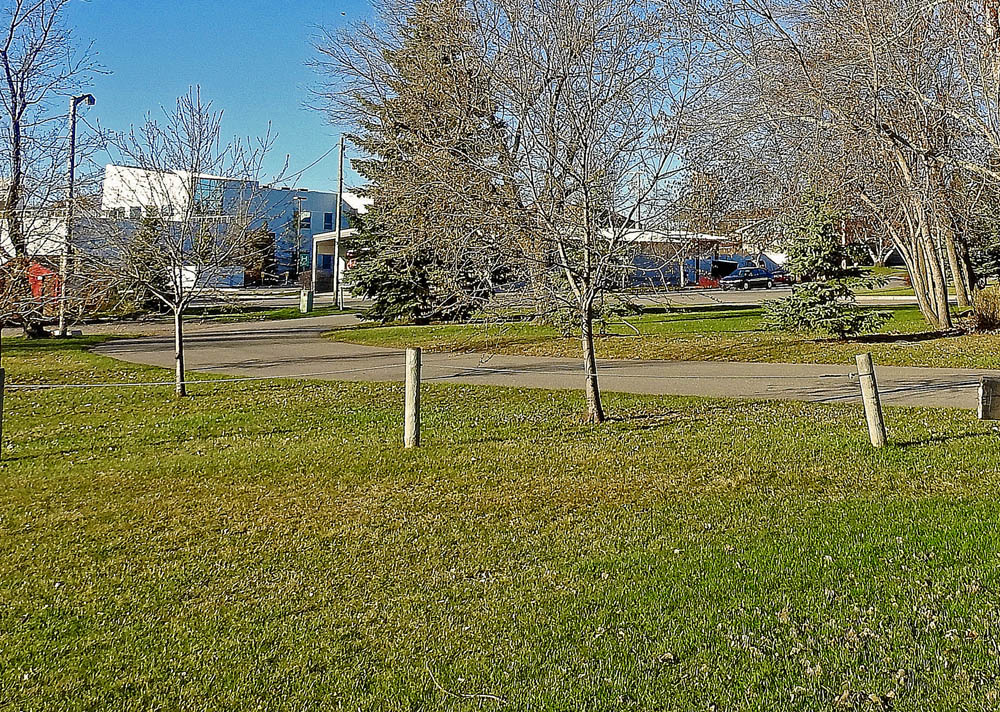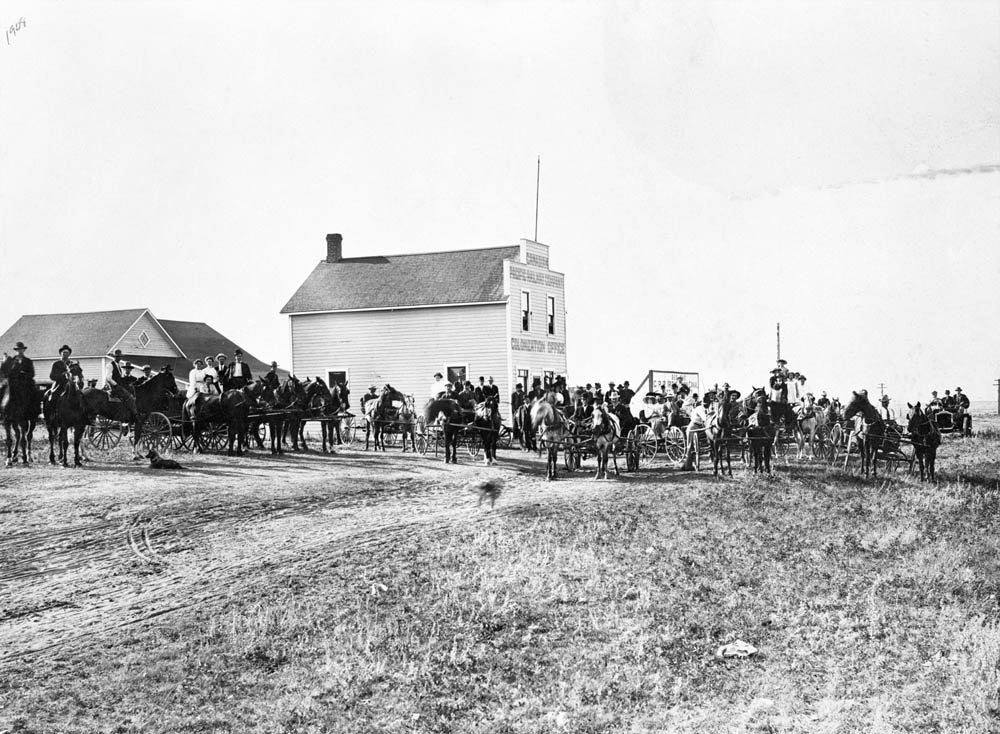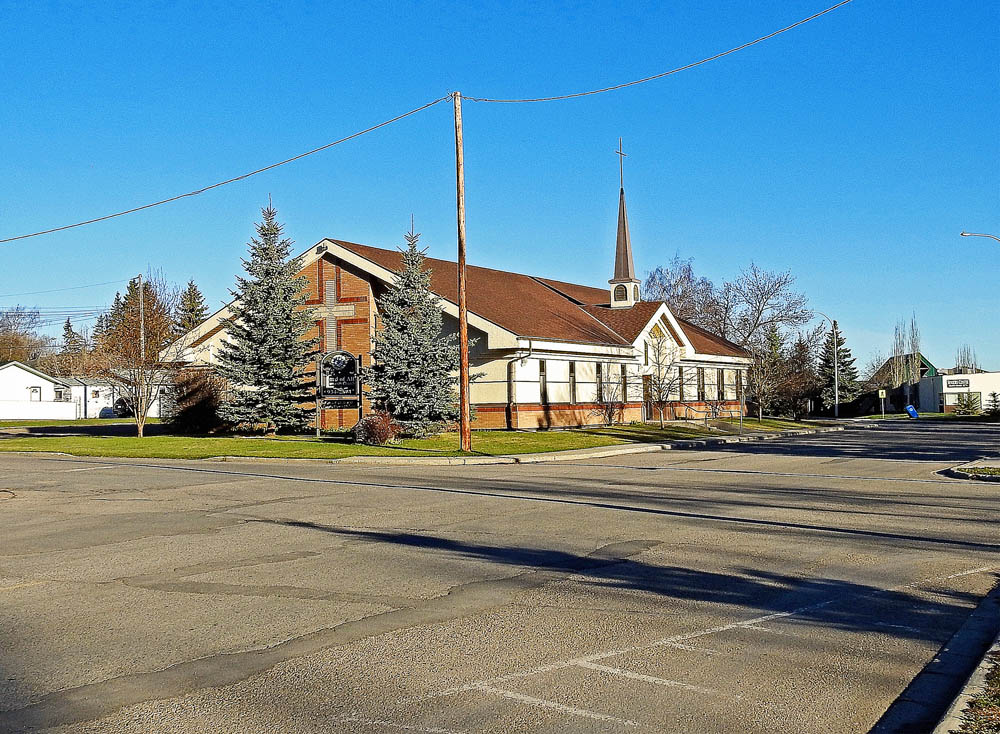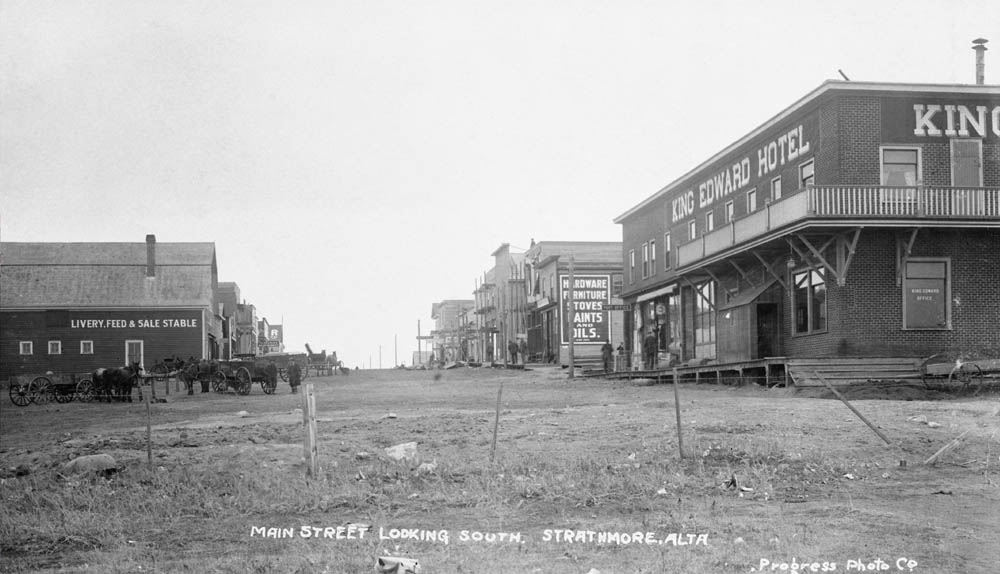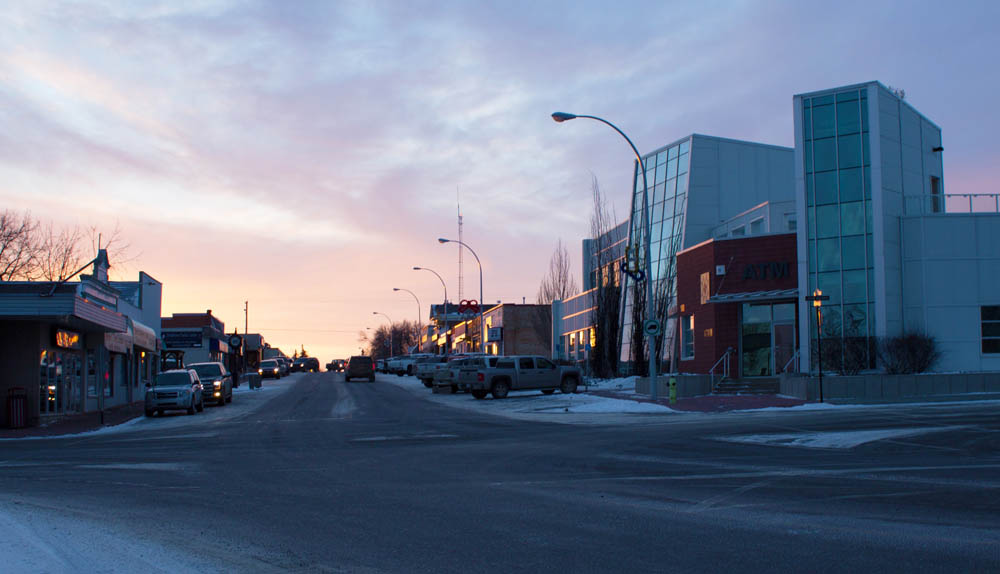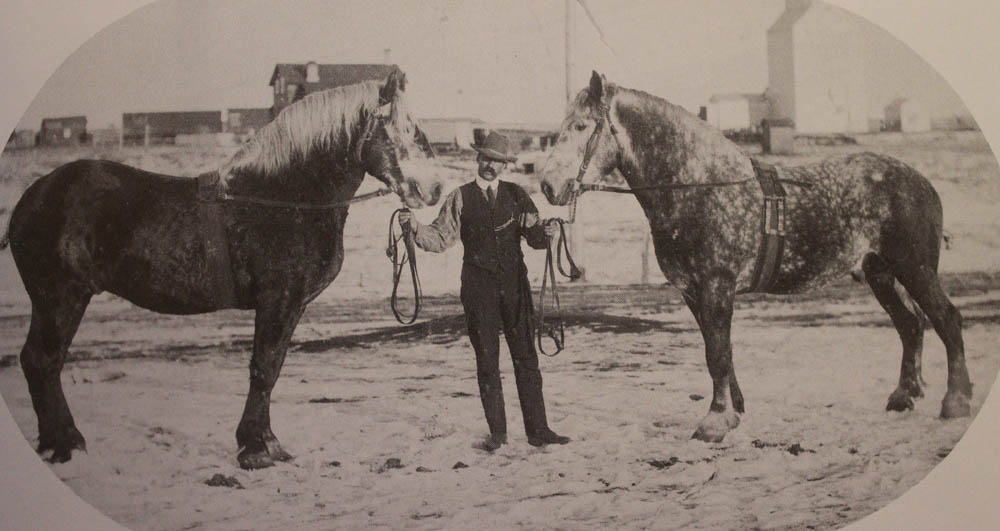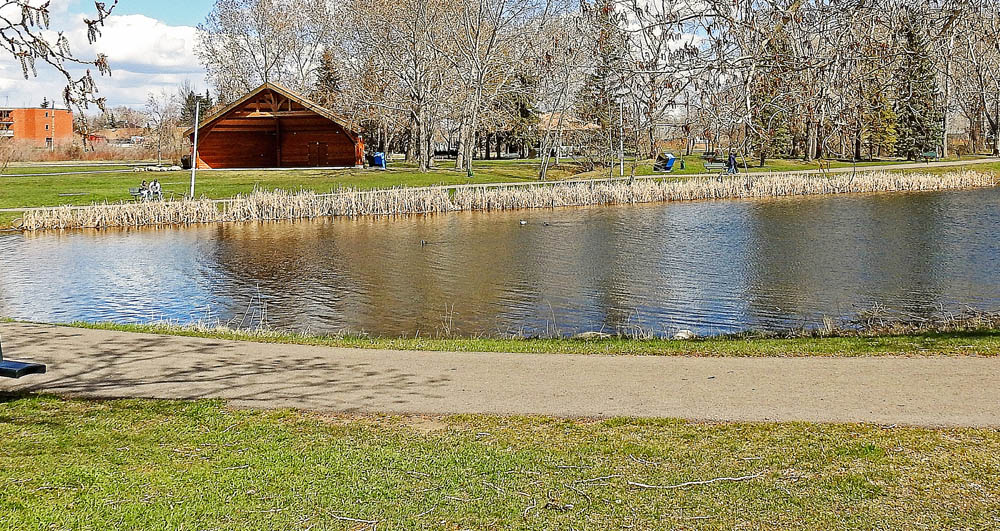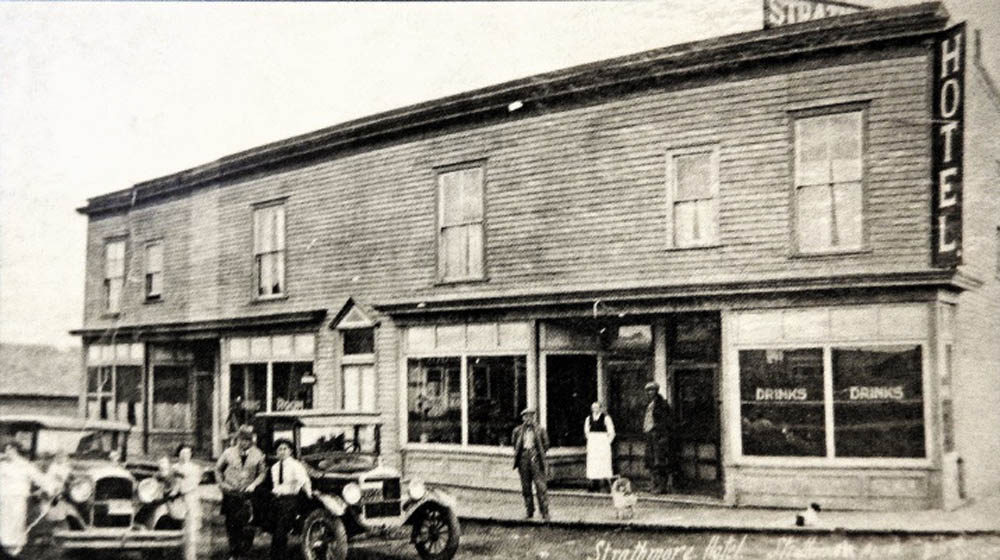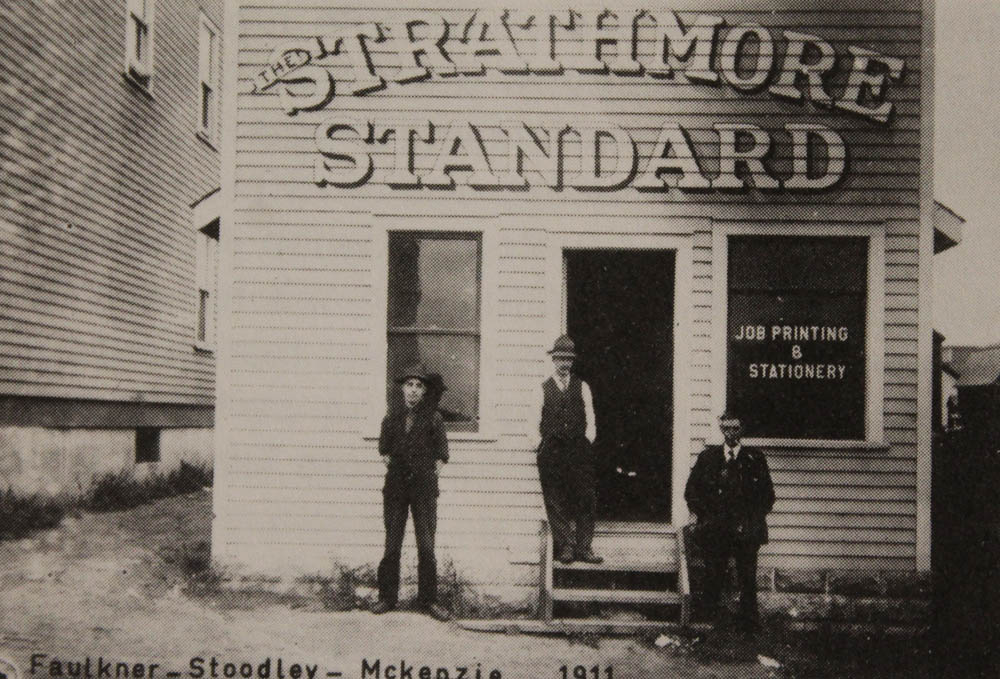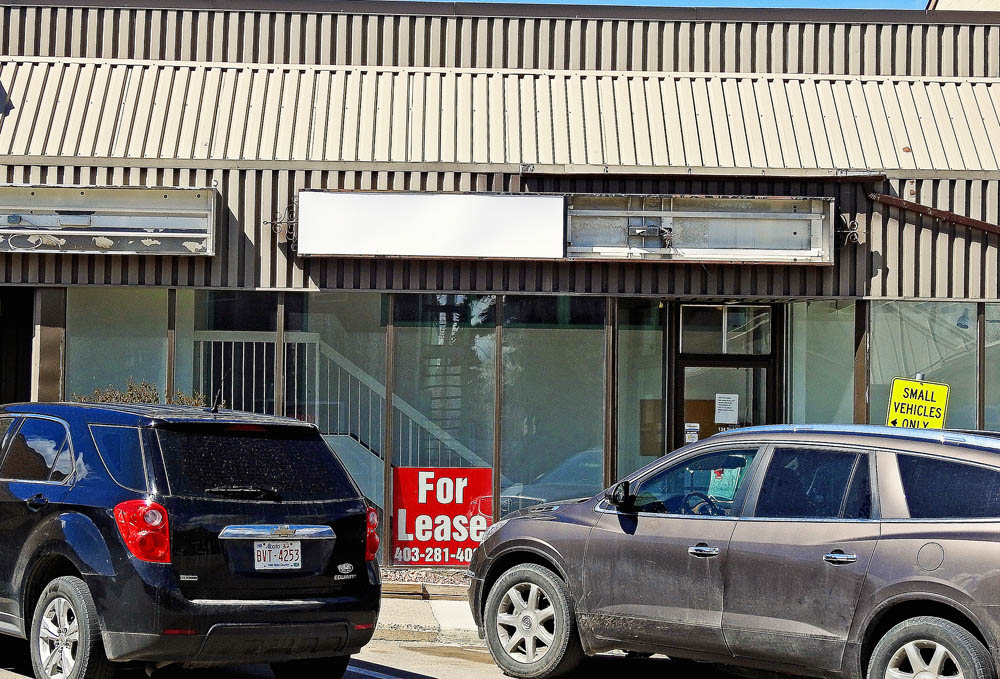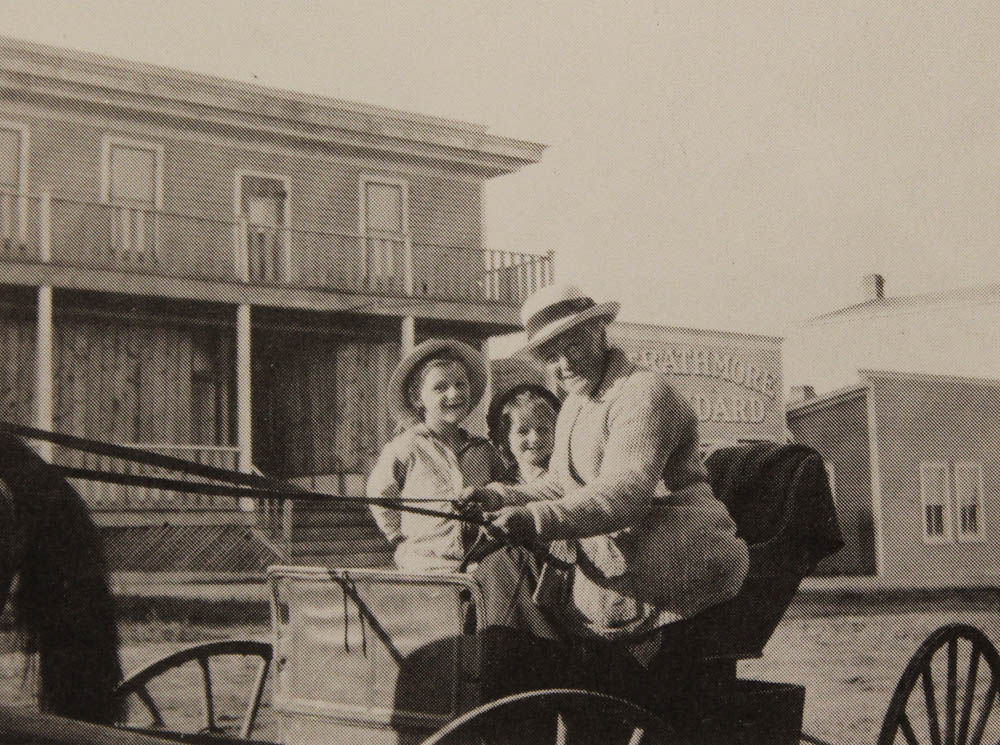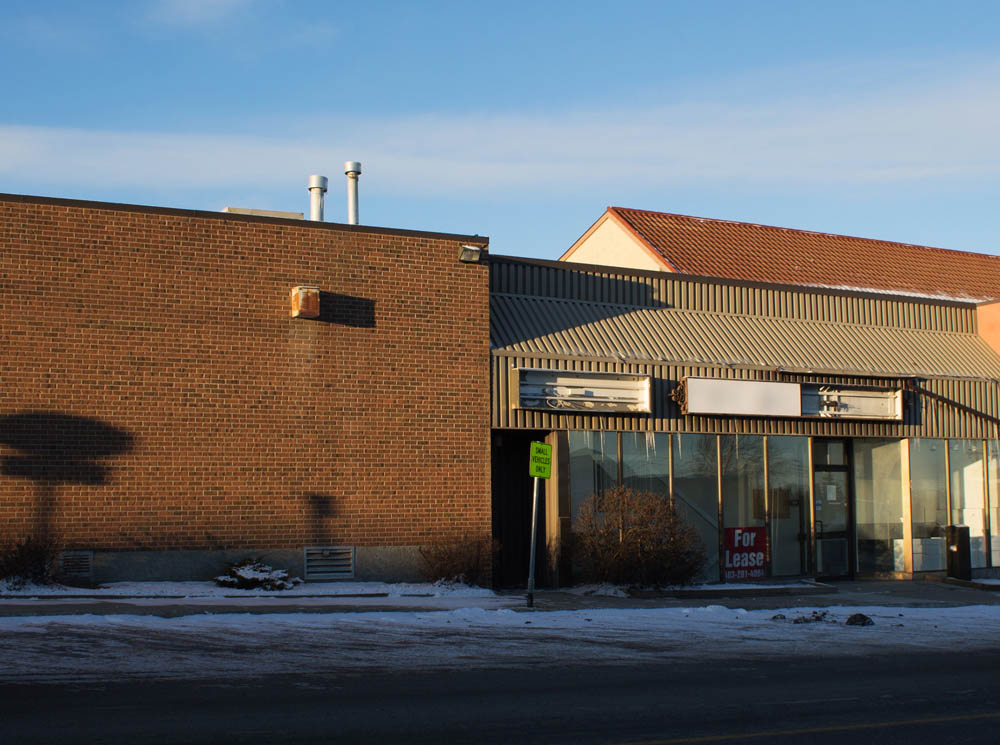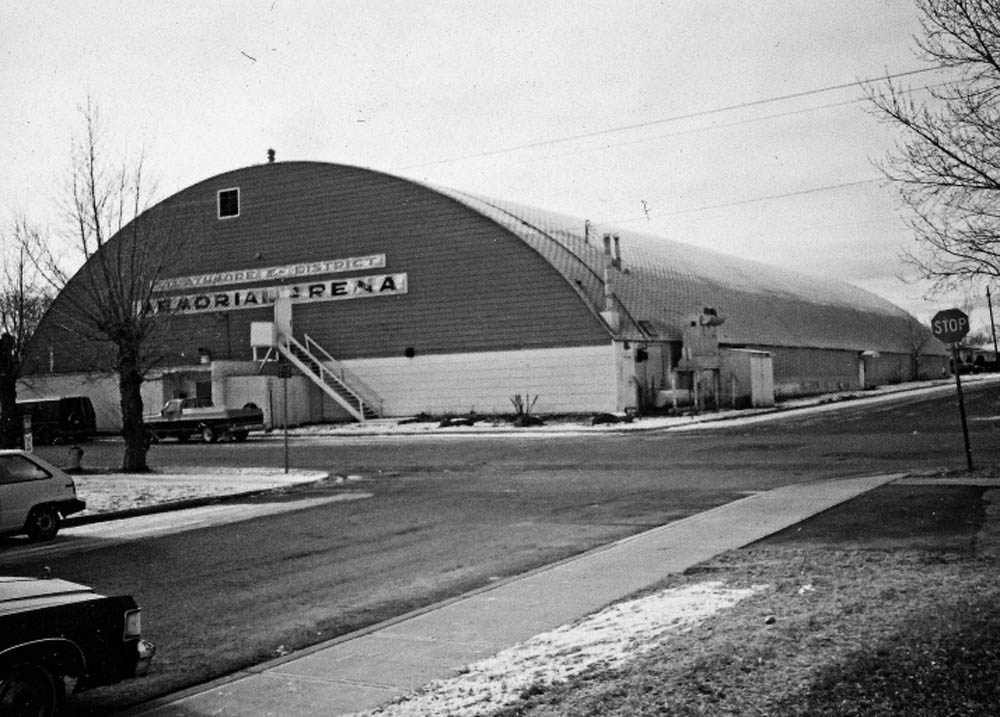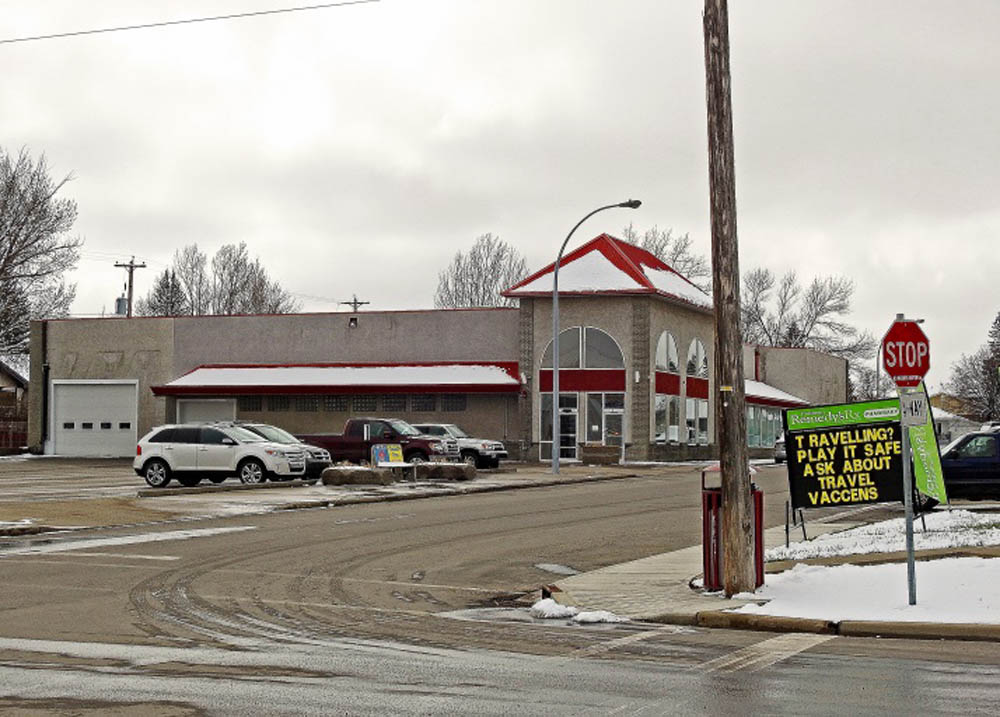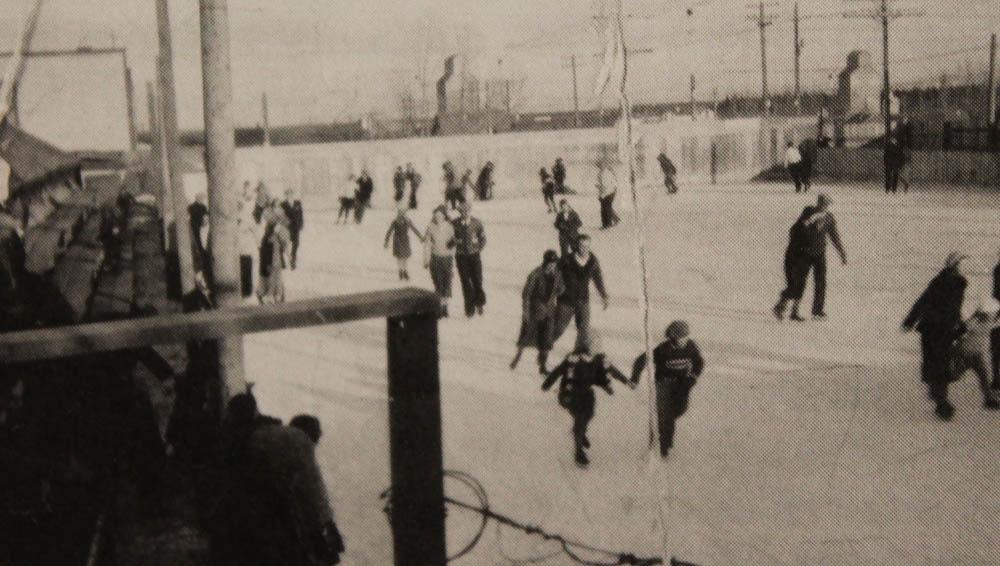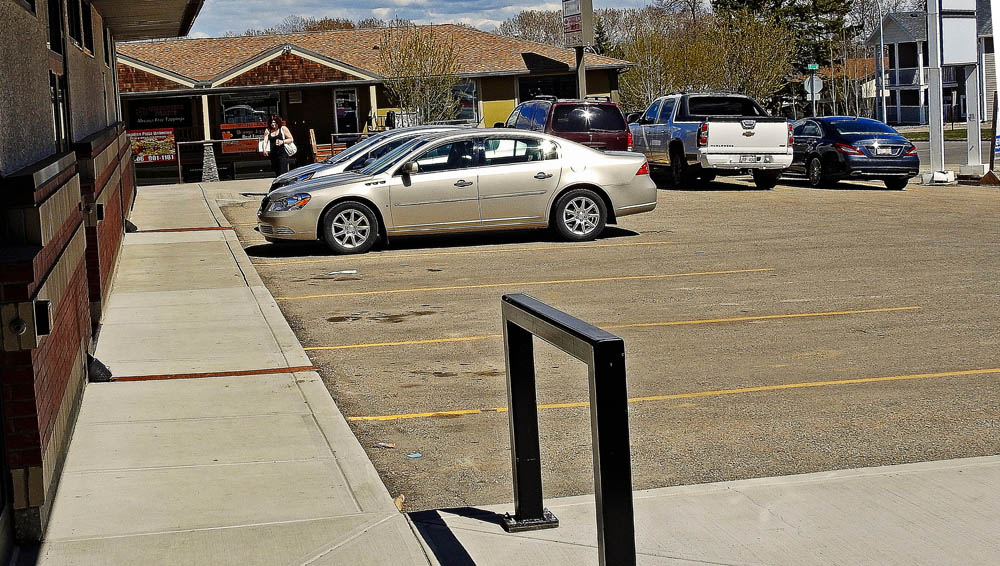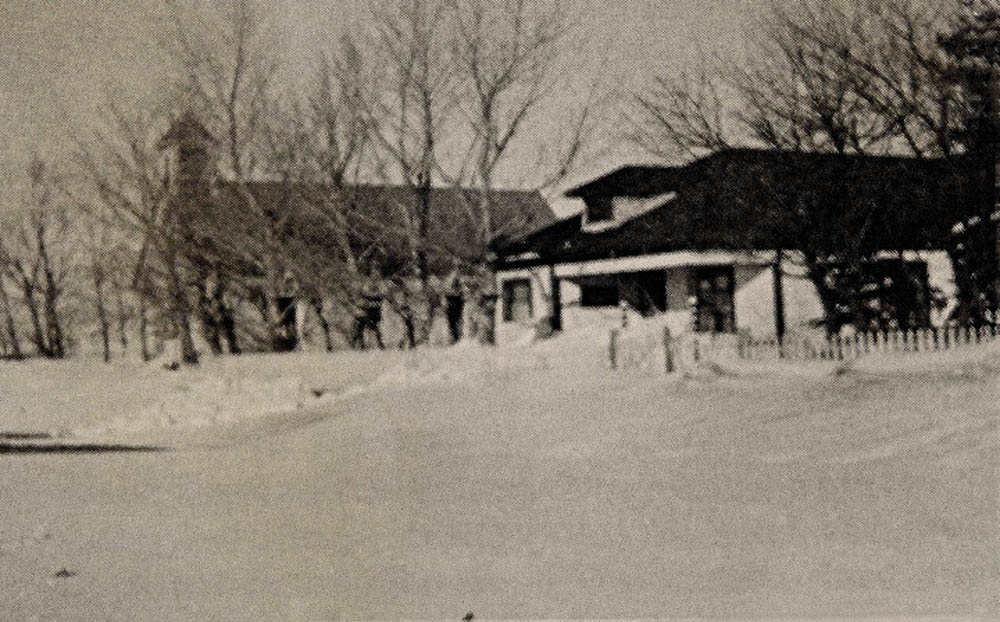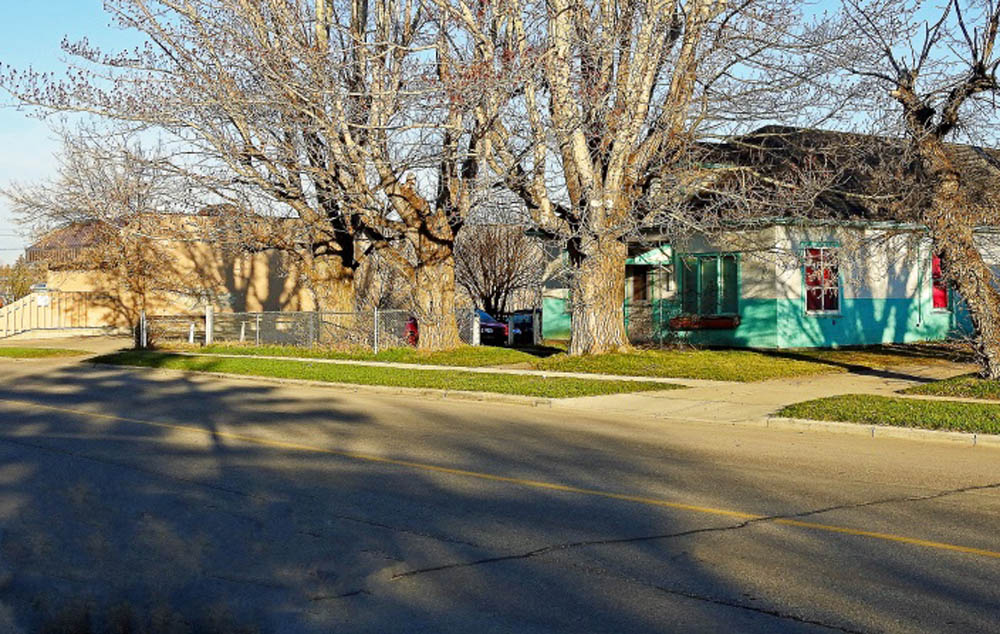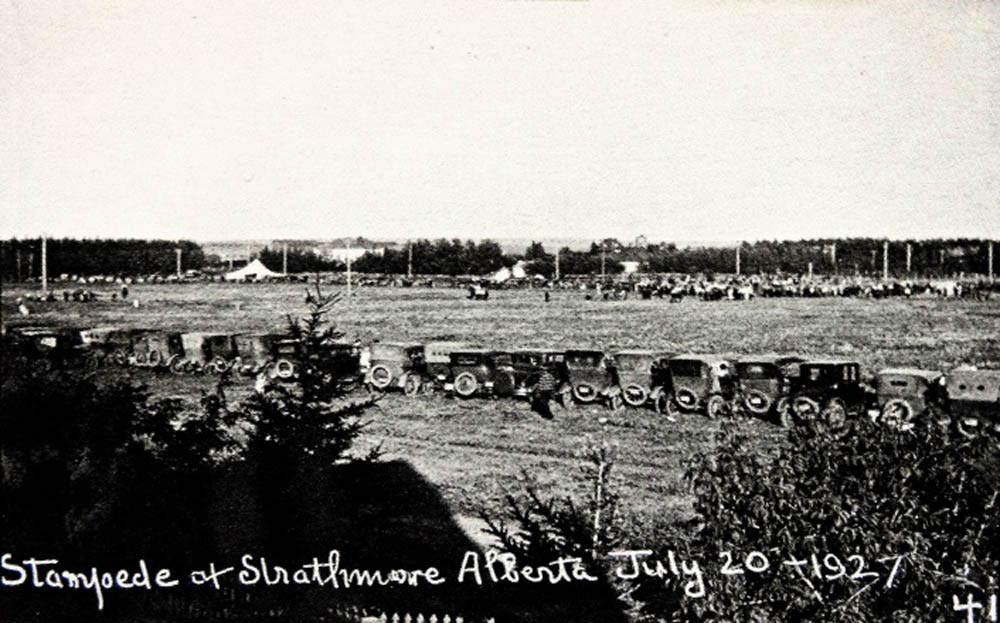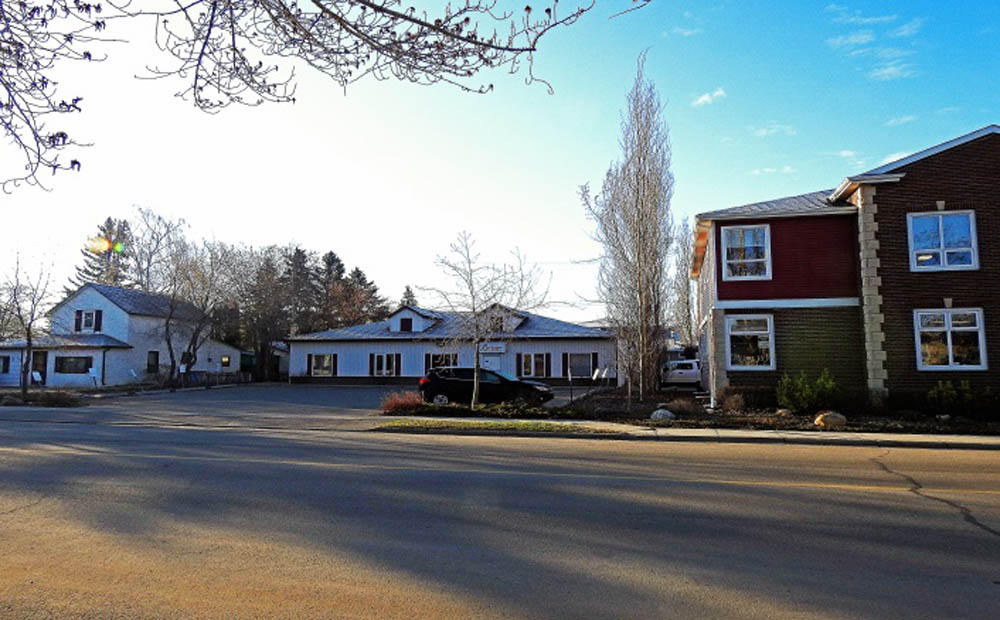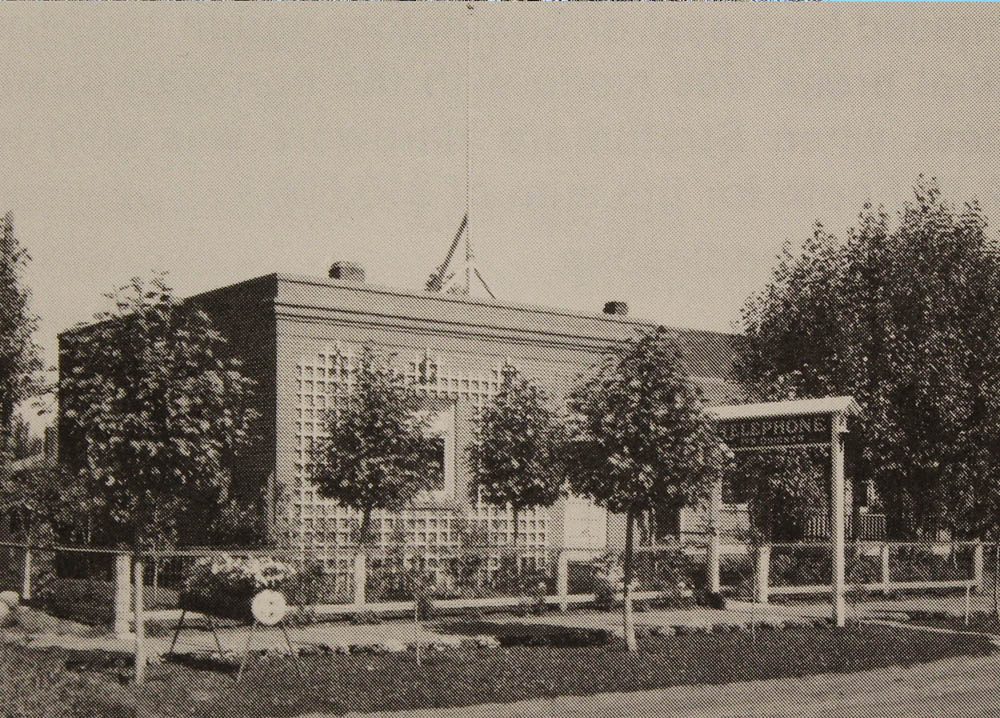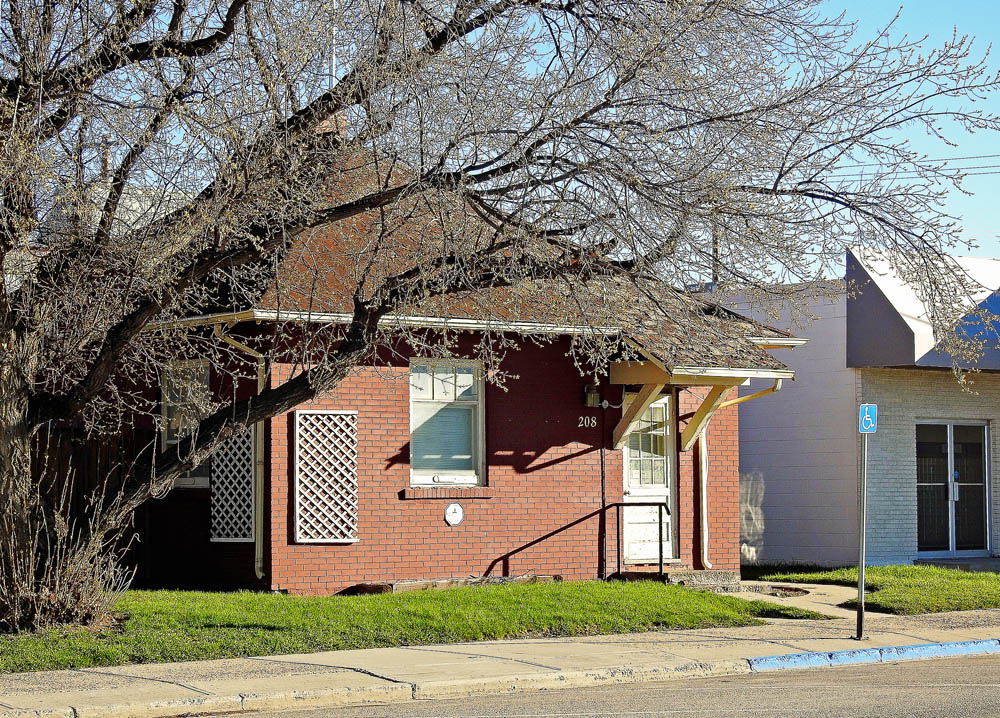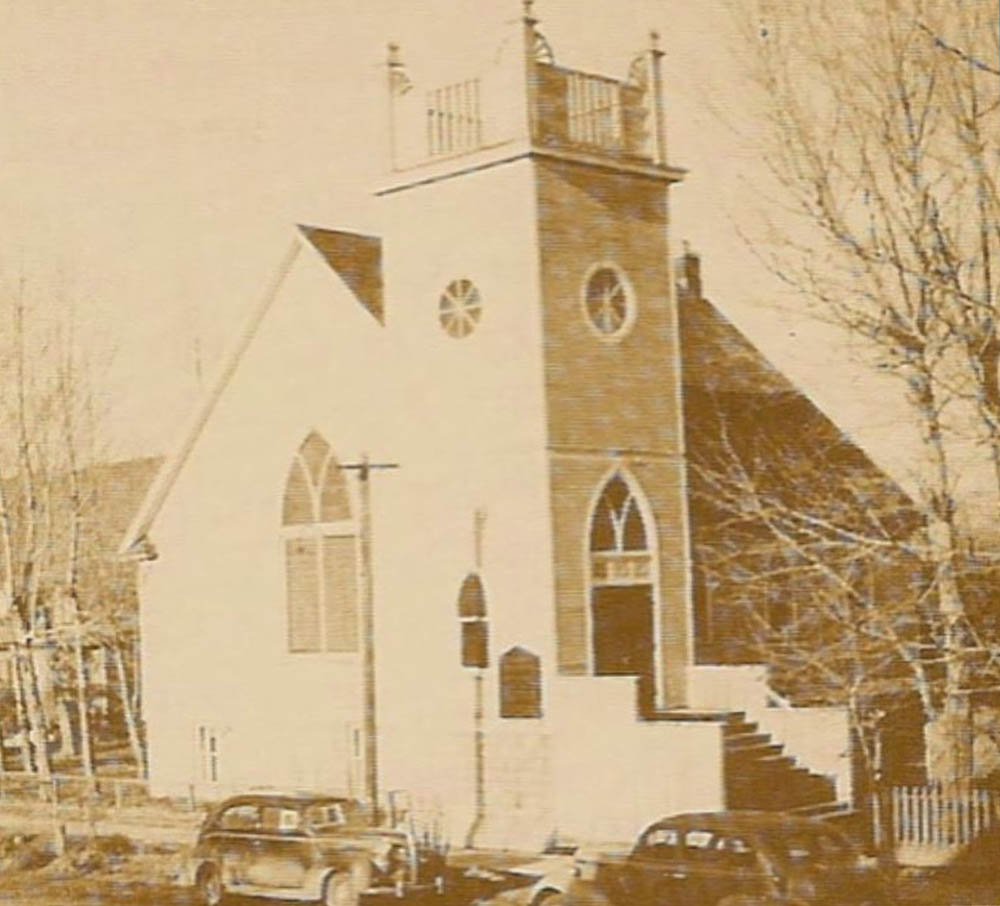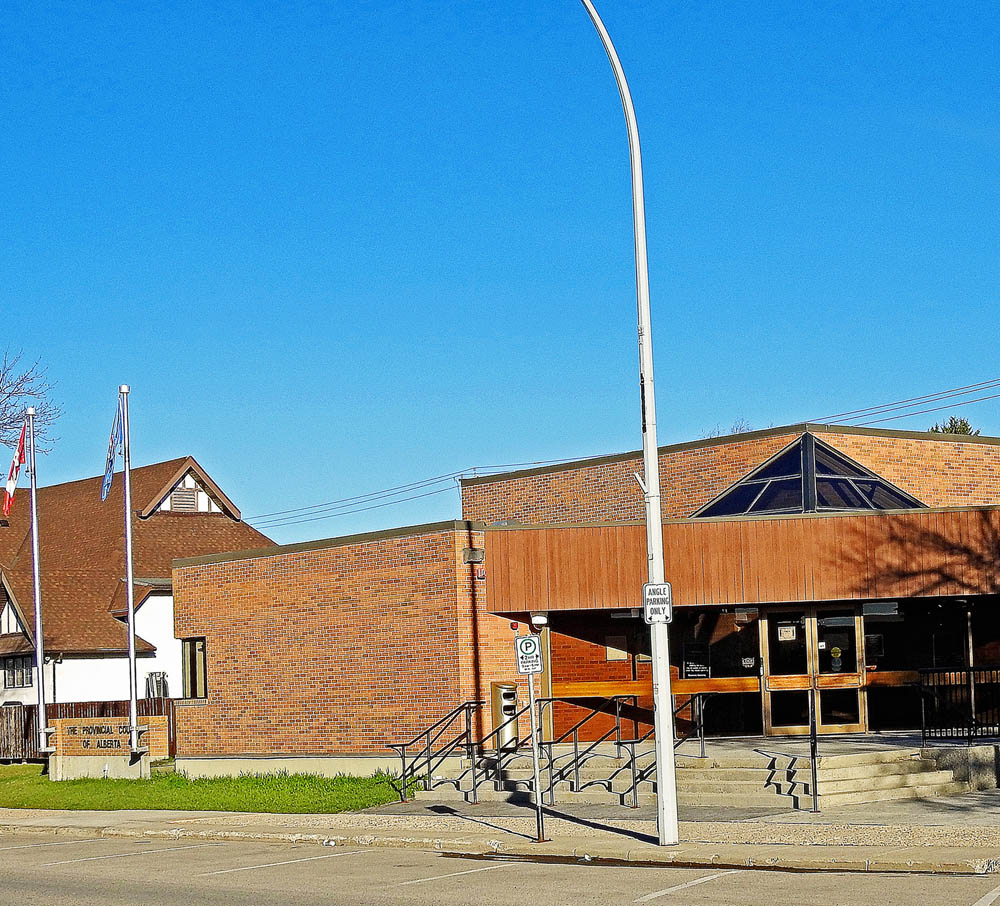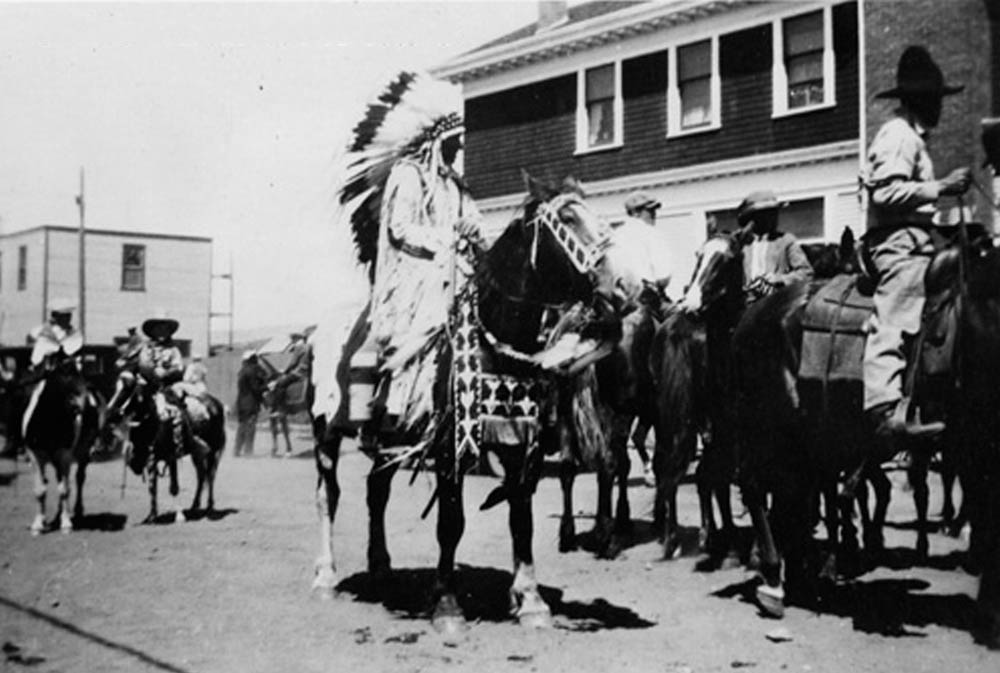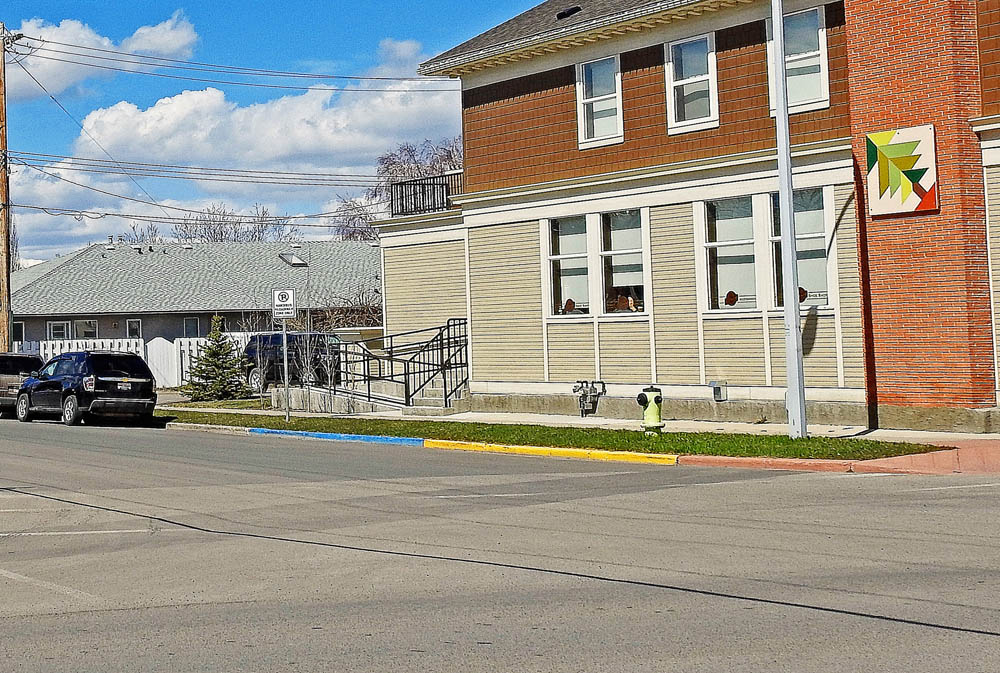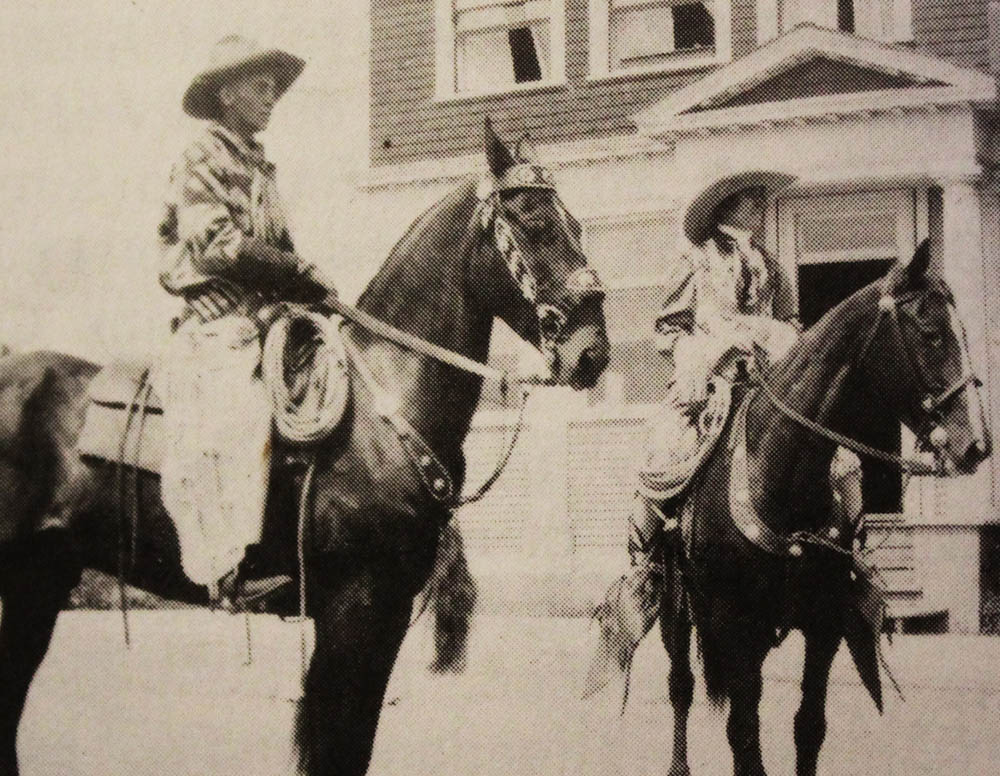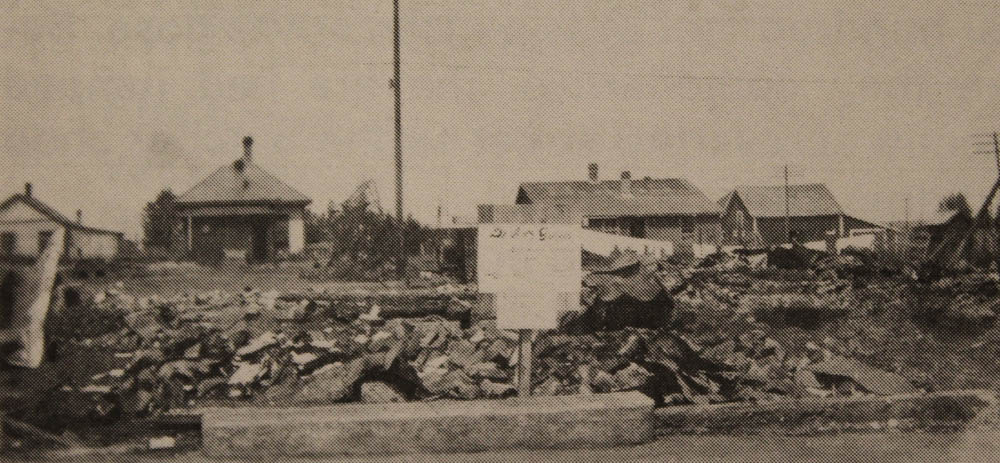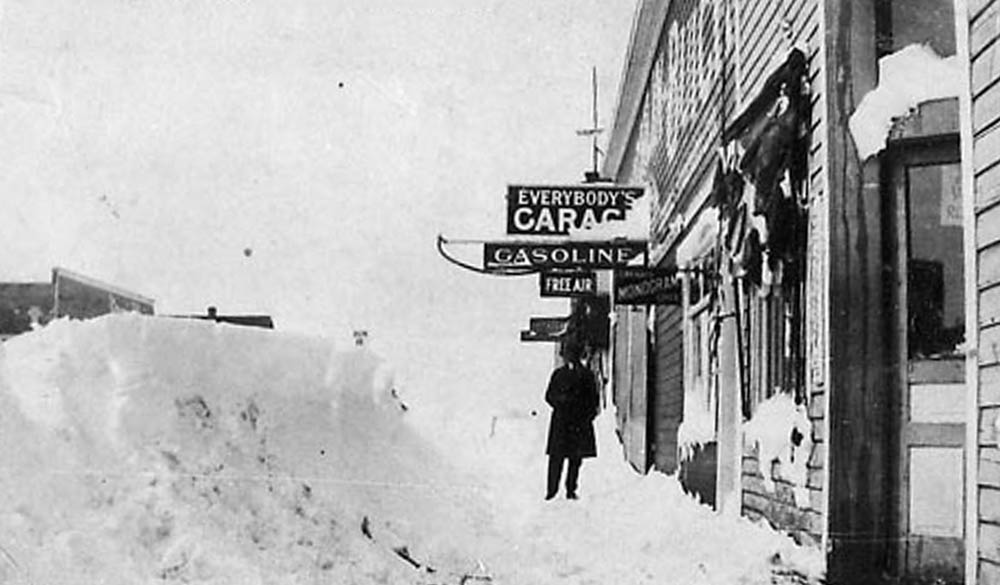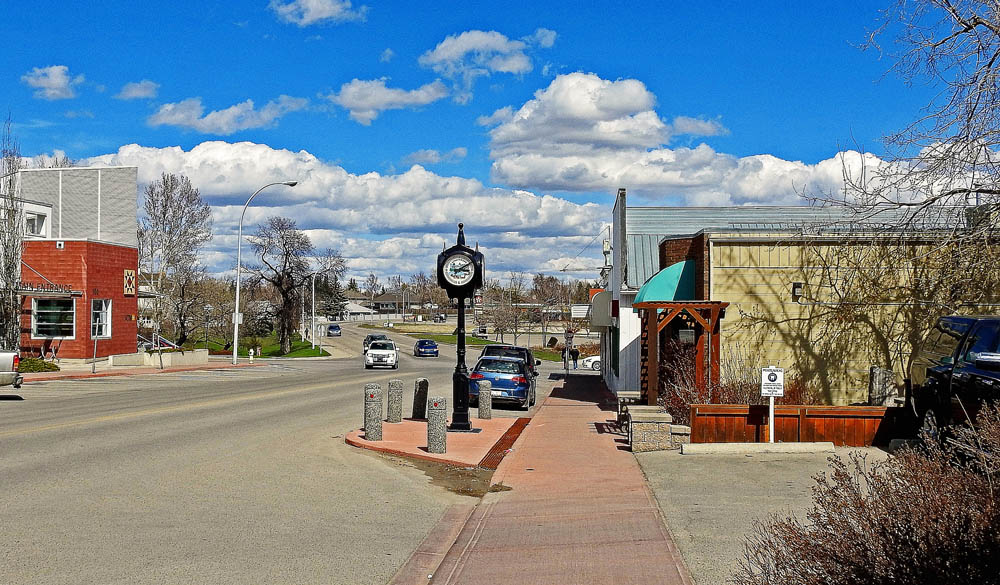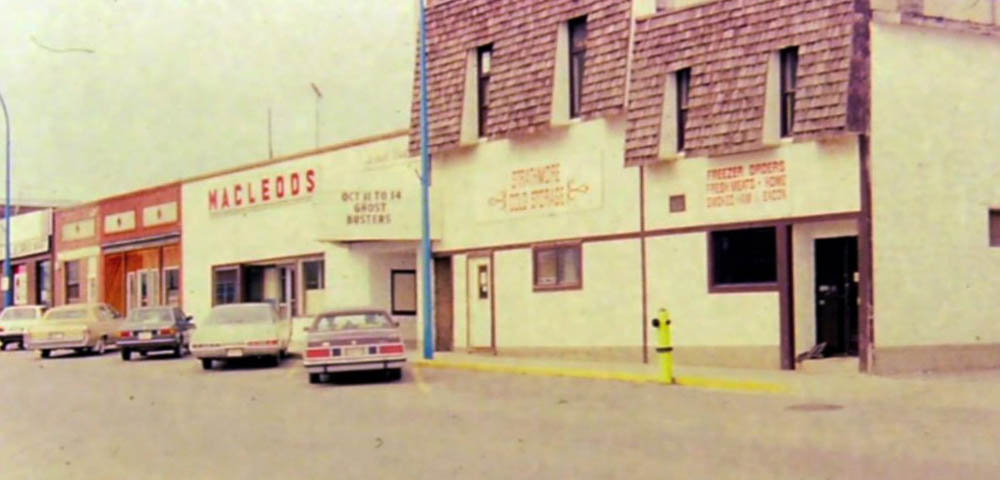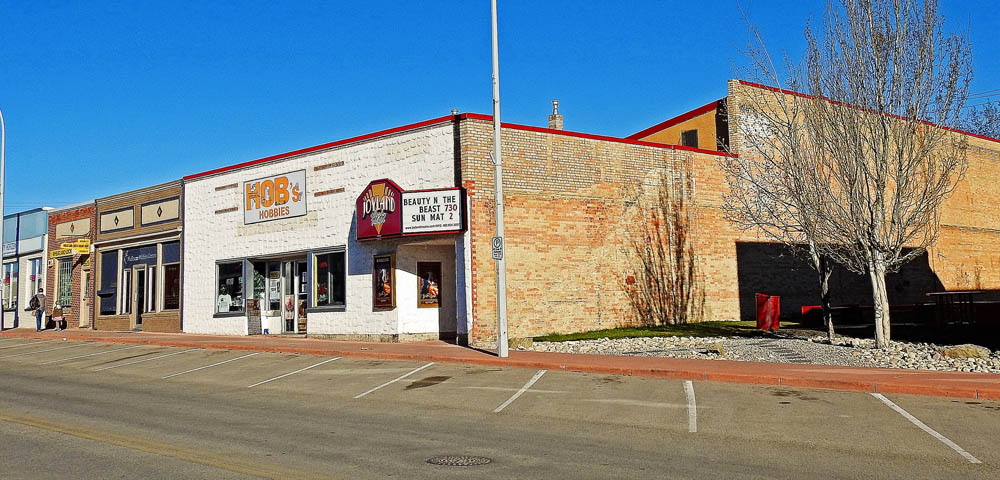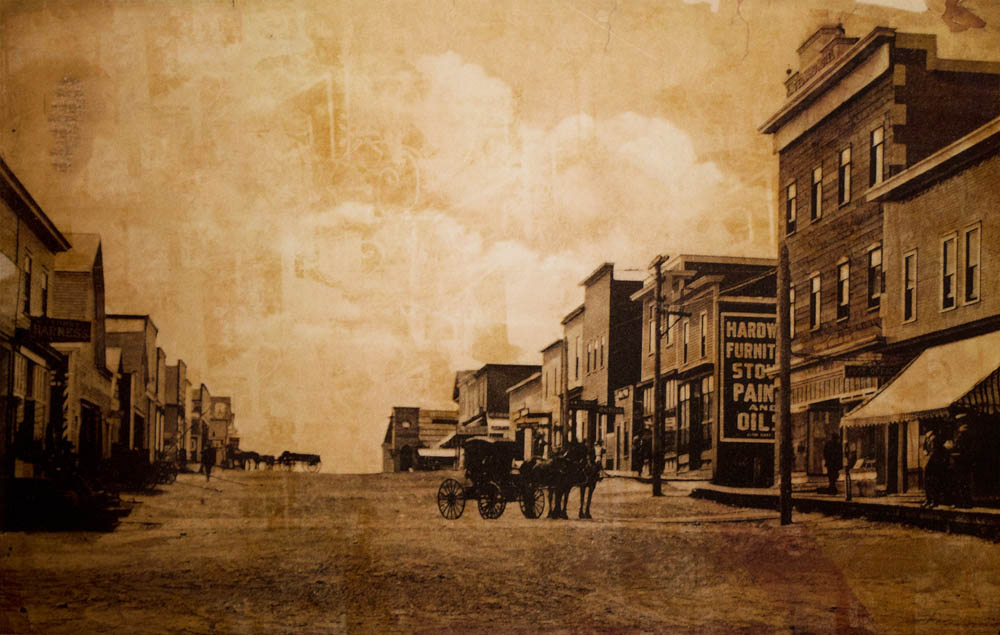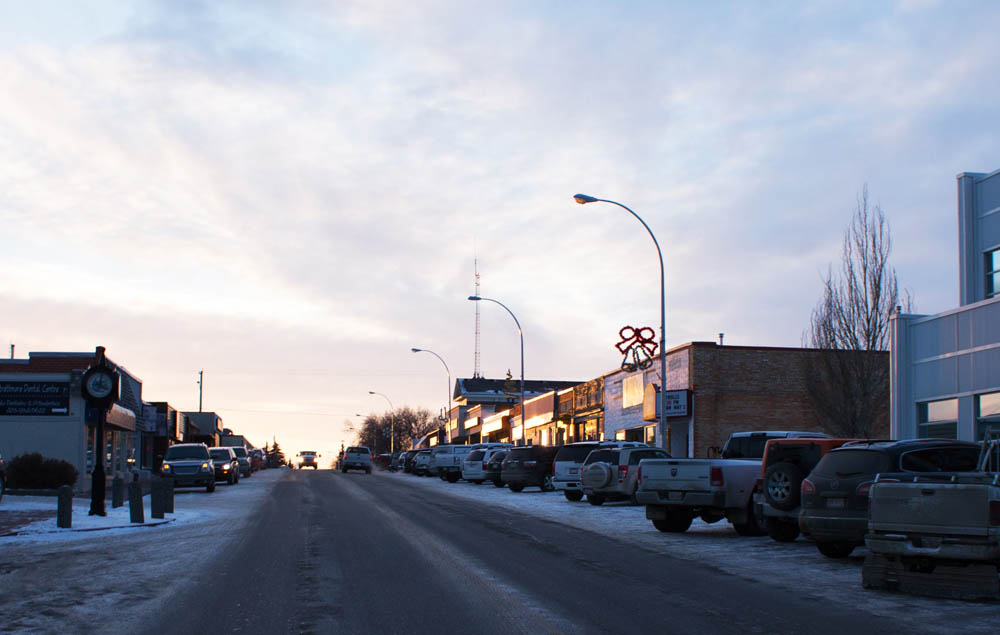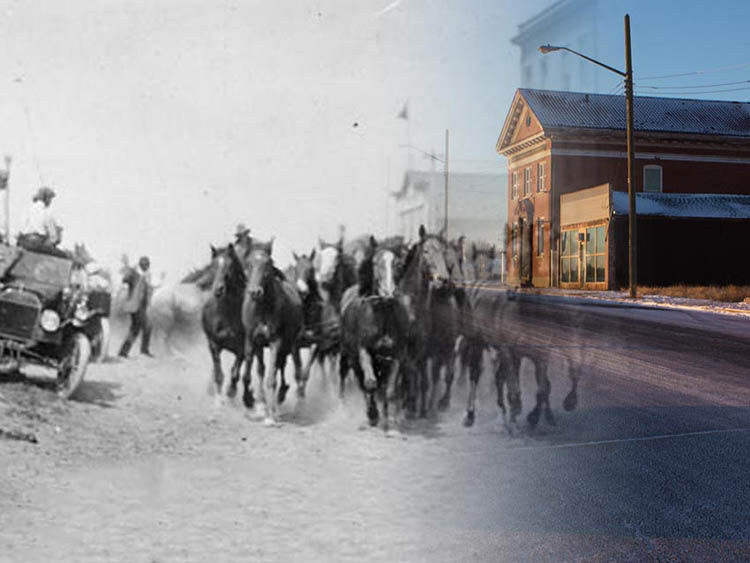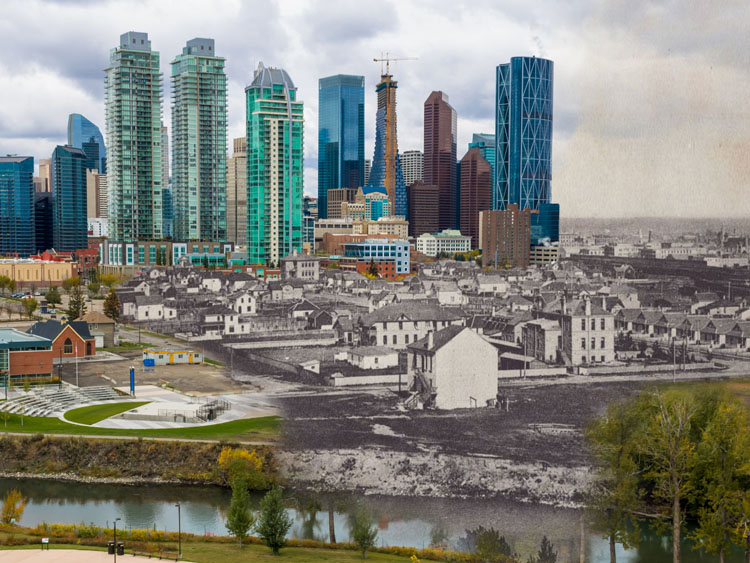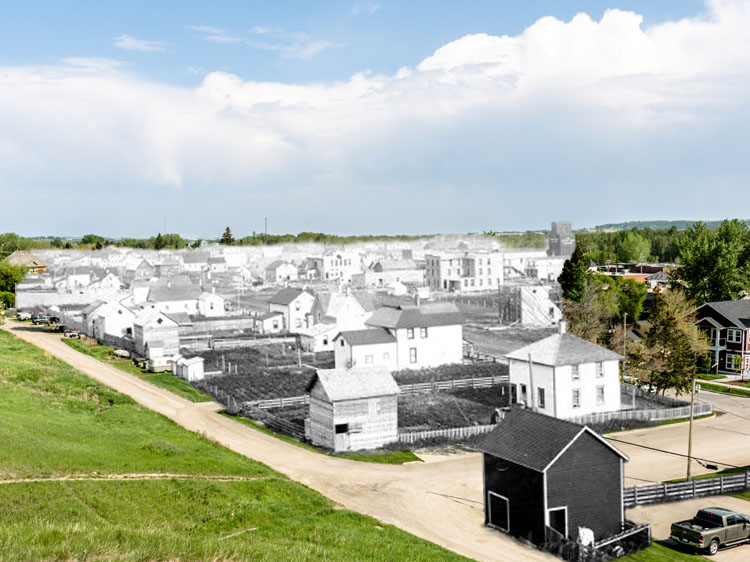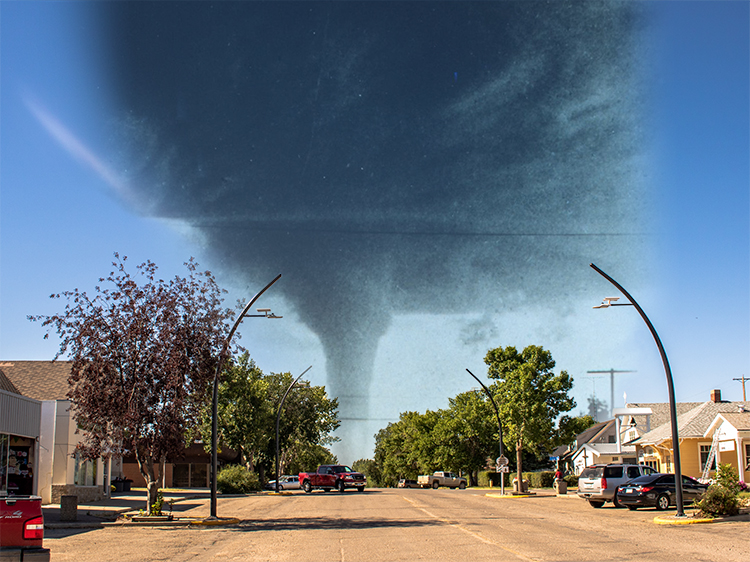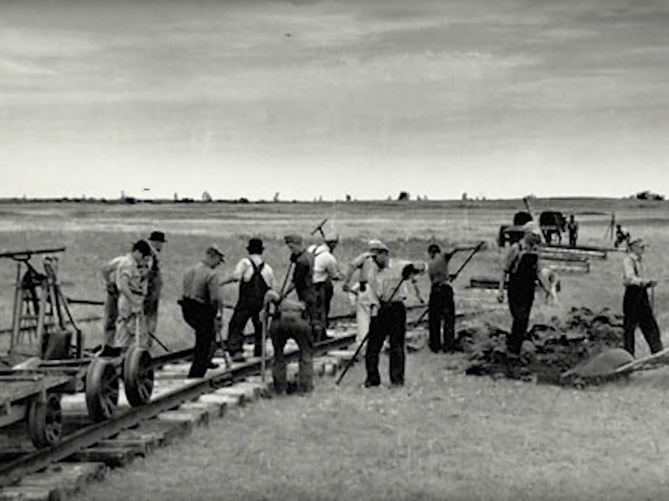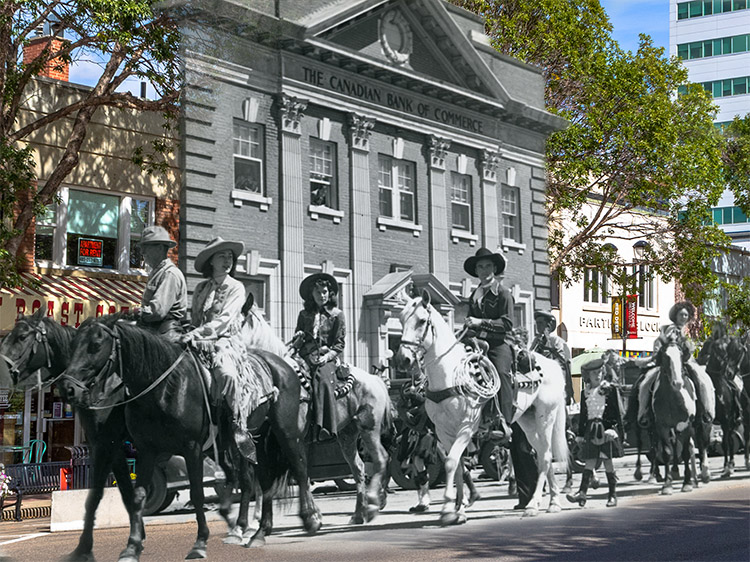Walking Tour
Life in Strathmore
The Village that Moved
Andrew Farris
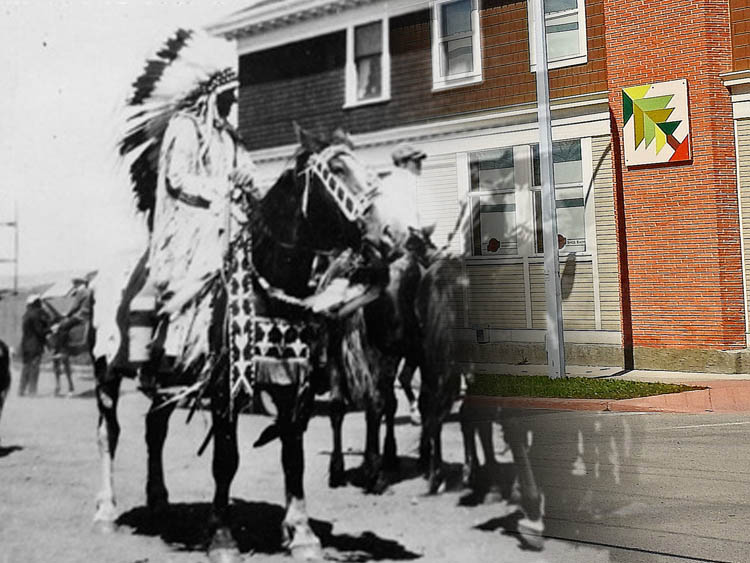
This walking tour will take you through the streets of Strathmore to explore the history of this prairie town. We'll see how the Canadian Pacific Railway established Strathmore as a farming community in the early 1900s which was aided by the construction of a massive irrigation system to sustain the farmers in the surrounding area. We'll discover different aspects of life in the town, from sports to religion, and the role of women. Finally we'll see how Strathmore has evolved over the decades to become the town we know today.
This project is only possible with the generous sponsorship and support of the Western District Historical Society. We also owe thanks to the Town of Strathmore, the Strathmore Travelodge, and members of the Western District Historical Society.
1. Humble Beginnings
1907
Strathmore's railway station once stood on this spot, alongside the tracks that formed the town's lifeline to the world in those exciting pioneer days over a century ago. This photo was taken just before a permanent station was built, as setters were just beginning to arrive in the town. Any retelling of Strathmore's story must begin with the railway, as it was the railway that came first and the town that followed.
* * *
This did not deter the Canadian Pacific Railway (CPR). They pushed ahead with the railway at a fantastic pace, and in the summer of 1883 they covered the section between Medicine Hat and Calgary in leaps and bounds. The track-layers zoomed through Strathmore on July 28, laying over 10 kilometres of track in a single day--a Canadian record.2
As the tracks surged across the prairies the CPR planted stations and towns at regular intervals, each separated by the distance a horse drawn wagon could haul grain in a single day. With systematic precision over 800 stations and 100 town sites were laid down west of Winnipeg.3 Siding #16 west of Medicine Hat, was hardly a suitable name for a town, and it is believed a Scottish surveyor working for the CPR first named the place "Strathmore", which means "Large Valley" in Gaelic (it was probably named after the Earl of Strathmore, rather than because there's a large valley here).4
Strathmore was actually originally located about four kilometres south of where you are now standing, just west of Eagle Lake. There it remained for two decades after the railway passed through, little more than a couple shacks inhabited by a lonely sectionman. The CPR's plans to fill the region with farmers remained unworkable until a comprehensive irrigation system could be built, so in the meantime the land was given over to ranchers and Strathmore served as the chief cattle shipment point in the region. It is thought over two million cattle were embarked on trains at the original site.5
Finally, in 1904, the CPR began work on the massive irrigation schemes that would make the land around Strathmore arable, setting the stage for settlement of the land and founding of the actual town. However the relatively steep grade from Eagle Lake to the current site of Strathmore caused westward bound trains to struggle to gain speed from a stop. To make life easier for the overworked train coal shovellers, the station and the town to be built around it was moved to the top of the grade, to the spot where you're standing now, earning Strathmore the nickname "the village that moved".
2. The Settlers Arrive
1907
Newly arrived settlers set out from the colonization office on the left, to scout out the land and pick a site for their homesteads. The life that awaited these bold pioneers was one of endless work, brutal climate conditions, and crushing loneliness. One resident recalls his great-grandfather telling him a saying about the pioneer life: "The first generation dies. The second generation works, and the third generation lives well."
* * *
The CPR owned all the land around Strathmore "as far as the eye can see" and they weren't in the business of giving it away for free, and irrigated land was worth considerably more, from $18-25 an acre. One CPR advertising pamphlet quoted the McElhoes of Strathmore as paying $1,943 for land, equipment, a house and a cow, or over $40,000 in today's money. A shortage of labour, a chronic Alberta problem, cost $75 a month in those early years.3
Most of these settlers who arrived on the prairies were effectively starting from scratch. One described the bewildering experience of first reaching his land parcel: "So there you are and the land guide says, ‘You are located on your land now'.... No semblance of roads or anything else. ‘Now there you are boy… Get busy and build your house, put in your garden and look after your houses and you will do all right,' and he went away. You are abandoned."
In our carefully ordered modern world, such terrifying uncertainty is difficult to grasp, and for many the demands proved too much: 45% of early Alberta homesteaders called it quits within three years.4
But as the iconic Canadian historian Pierre Berton wrote, we can see amongst those who stuck it out the early shaping of the peculiar Alberta character: hardy, self-reliant and community oriented.
"Whether he came from the Caucasus or the Black Hills, from Petworth in Sussex or Coboconk on Ontario, almost every settler experienced in some form the drudgery, the monotony, the loneliness, and the terror of homestead life. They never forget it. In later years, when life was sweeter, when the frame farmhouse had replaced the log shack that had replaced the sod hovel, they looked back on it all with wonder, pride and not a little affection. The dreadful food, the fearful prairie fires, the terrifying white-outs became part of a prairie tradition… They were members of an elite, these prairie pioneers; they had come through experiences that no other Canadians would ever understand."5
3. The Town Emerges
1912
An early shot of Strathmore's main street. On the right is the King Edward Hotel, centerpiece of the town's social life, while hardware stores, stables, banks and churches further up the street served the farmers in the surrounding area. At Strathmore's incorporation as a town in 1911 the population stood at 520.1 After that initial burst of growth the town's size and shape were set down. It would change remarkably little for over 50 years.
* * *
The lack of buildings did not belie a lack of planning. The CPR, ever ready with an ambitious master plan for the places their railways touched, laid out the town's grid pattern facing the station which was first built in 1907. They set aside blocks of land for the school, town hall, and set up a demonstration farm to assist the pioneers setting up their farmsteads. They also took the important decision to make Strathmore the headquarters of the Western Irrigation District, an area of 85,000 acres criss-crossed by an impressive array of dams, canals and ditches to supply water to the region's farms.3
By 1910 three grain elevators, those archetypal prairie landmarks, dominated Strathmore's skyline, proof of the success of the irrigation efforts in making the land fit to grow wheat.
Businesses and homes for the townsfolk who worked in them were built at a frantic pace. On May 21, 1910 the new newspaper, the Strathmore Standard, boasted of the speed of construction using a rather odd metric: "It is estimated by our statistical expert that there are twice as many blows struck with a carpenter's hammer in Strathmore than any other town between Medicine Hat and Calgary."
Nearby Gleichen had just incorporated as a town, and not wanting to fall behind in the local rivalry, the Standard opined, "It is not fitting that Strathmore should lag behind. We have well over the required population and there should be no obstacles of any importance."4
Strathmore's enthusiastic inhabitants needed no further encouragement and on January 3, 1911 they gathered on Main Street in sub-zero temperatures to unanimously vote in favour of incorporation. Strathmore had arrived.
4. Boomtown
Strathmore: The Village that Moved, 209
1910
Bill Knyvett stands with two horses in Lambert Park, today called Kinsmen Park. Boxcars in the back indicate where the railway once ran. Trains were eagerly awaited, as each delivered new settlers, building materials, shop inventories and mail to the booming community. Bill, an immigrant from New Zealand, set up the first livery stable in Strathmore, and is advertising his horses in this photo. Both Bill and his brother Edward enlisted to fight in the First World War and Bill would be gassed at the Second Battle of Ypres before being invalided home. Edward was killed at the Battle of Mons.
* * *
As Prime Minister Wilfrid Laurier said in his speech in Edmonton on September 1, 1905, when Alberta joined the Canadian Confederation: "We do not want nor wish that any individual should forget the land of his origin. Let them look to the past, but let them still more look to the future… Let them become Canadians, British subjects and give their heart, their soul, their energy and all their power to Canada, to its institutions, and to its King."1
In addition to homesteaders, groups of young men came to Strathmore to work for the CPR building the irrigation system. Many spent $6 a week to room in the King Edward Hotel, which was built by the town's first entrepreneur, George Lloyd, and run by his kindly wife, one of the few women in the town in those first days. .
No slouch, Lloyd wasted no time in expanding his miniature business empire to include a general store, livery barn, post office and opera house. Yet, Lloyd was not immune to the often transient nature of life in these frontier towns, and in 1912 him and his wife sold all their businesses and moved elsewhere.2
5. The Duff Block
1920s
When Strathmore’s business district first began to develop, it encompassed portions of today’s first, second and third avenues. This was to change as the business centre became concentrated on 2nd Avenue which would become known as the “Main Street”. Initially constructed as a commercial building in 1908, the Duff Block on 3rd Avenue was to eventually become the Strathmore Hotel.
* * *
After the prohibition years (1916 to 1924) ended, the building was gradually modified with the ground floor accommodating a café and bar. The upper level became hotel rooms, and the Strathmore Hotel was born.
Owned and operated by a number of managers over the years, the Strathmore Hotel luckily escaped the usual death by fire, the bane of many small town hotels, and still stands today as Strathmore’s oldest remaining commercial business building.
6. The Strathmore Standard
Strathmore: The Village that Moved, 76
1911
On this spot was once the tiny office of the Strathmore Standard, the newspaper that kept its finger on the pulse of the young community. Standing on the right is John Mackenzie, a Scotsman who was to remain the paper's editor through those exciting pioneer years. The Standard, like newspapers in towns across the prairies, played a hugely important role in fostering a sense of pride and community amongst the farmers and the townspeople, and in bringing them news of the outside world.
* * *
The humble beginnings of the Standard, like that of the town, couldn't dampen the boundless optimism that shone through in that first edition over a century ago:
"Magnificent as has been the progress of the Bow Valley during the past twenty-five years, it will appear but trifling to what will be accomplished twenty-five years hence. Every year the tide of immigration will become stronger, new railways will be completed, new towns come into being, and towns already in existence will increase greatly in size. Factories will be commenced, the mineral wealth of the district tapped to a greater extent than heretofore, and activity increased in a thousand and one different ways.
"It will be the aim of the Standard to faithfully record the development of the district, and to assist it by every one of the various means which a newspaper can employ to do so."2
That optimism wasn't unique to Strathmore. The vast, open skies and limitless potential of the land infected all who immigrated to the new province. As one traveller remarked, "there are not half a dozen wooden shacks on the prairie, called a ‘town', where the inhabitants do not believe that in a very few years that town will be one of the most famous and prosperous cities in the entire Dominion."3
7. The Pioneer Women
Strathmore: The Village that Moved, 97
1910s
Nurse Barr and a couple children ride a buggy past the Standard's office, and beside it to the left, the Maple Leaf Hotel. As settlers began setting down roots in the town, they were joined by more women and most started families. In frontier towns like Strathmore everyone was expected to work, and women took on many more roles than was usually the case in more conservative societies like England and Ontario where they came from.
* * *
To help ease the uncertainty of starting this new life, the community embraced the newcomers, and a highly active social life in the town helped preserve people's sanity on those long winter nights.
As the Standard's John Mackenzie wrote:
"It has been said that in our cities people can live for years next door to each other and never meet, but this could not happen in Strathmore. The newcomer, male or female, was the object of attention from the day of arrival. If of the fair sex she was very likely to have a tea organized in her honour. She would be sounded as to which religious denomination she belonged to, and within a week she would be embraced into sewing circles and various other activities. For the male of the species there was likewise no opportunity for being lonely. He would be sounded as to his fraternal and other affiliations, as to whether he could play baseball or ice hockey. Could he perform on any musical instrument? Was he fond of discussion and a debate? Strathmore has as yet less than five hundred inhabitants, but it already had several churches, as many lodges, a brass band, a baseball club, a hockey club, and numerous other organizations."1
Outside of the farmsteads, there were few job opportunities for women. The only occupations really available were nurses, teachers, clerks or domestic servants. Even then it was always expected that these jobs would only last until the woman had married, at which point she was to leave to raise children. In the 1920s only 3% of married women in Alberta worked.2
8. The Memorial Arena
1980s
Residents of Strathmore had made very good use of the fenced open rink despite subzero weather, chinooks and bad ice conditions, but in 1950 the outdoor arena had to be given up as it sat on commercial land which had been sold. The old arena was dismantled, and the lumber salvaged to construct a replacement on a nearby site. A herculean task at the time, volunteers undertook to raise funds and to construct a truss-roof building over the new arena with enclosed seating for 1,000 people on the sides and heated dressing rooms. Completed in December 1952, this magnificent structure was the envy of rural Albertans. Containing a huge volume of air, it was noted for being cold, as cold or colder inside than the air outdoors, even in summer, thus extending the life of the ice.
* * *
In 1953 a minor hockey association was organized. A league was formed with Bassano, Gleichen, Standard, Carseland, Crowfoot School and Old Sun School. Coach Jack Crellin’s 1959 Strathmore Midget Team won the Alberta Provincial Championship.
The Memorial Arena was the heart of this community. Annual ice carnivals had been enjoyed in Strathmore since 1912. The new arena with spectator seating proved the perfect facility. There was also a figure skating club. As well as the Bingo, summer events included B.B.Q.’s, , dances and the annual 4-H livestock shows and sales. In 1986 a large part of Strathmore’s 75th Anniversary Celebrations were held here. By 1988 the wooden building was showing structural issues and was closed and demolished. It remains a shining memory of a strong vital community, Strathmore in the latter half of the 20th Century.
9. The Love of Sports
Strathmore: The Village that Moved, 152
1920s
People watch a hockey game played out on a rink that once stood where this parking lot is. The elevators in the background once stood just behind Kinsmen Lake. Sports were an ever-present part of life in early Strathmore, with hockey and baseball proving the most popular.
* * *
Those Scottish immigrants brought golf with them as well, and set up a club to the north of the town that is still there today. Unfortunately golfers always struggled with maintaining greens on the thick prairie sod, and instead they had to make do with sandy greens. The other major summer sport was baseball, and some Strathmore boys even made it to professional teams in the big eastern cities.
Beyond that, the Strathmore Stampede was started in the 1920s. It proved a huge success and remains a major feature of Strathmore life to this day.
10. Sacred Heart Church
1930s
When the C.P.R. rails crossed southern Alberta in 1883, already missionaries such as the renowned Fathers Lacombe, Doucette and Scollen ministered to the Blackfoot Nation and early ranchers. In 1908 Fr. Van Aaken arrived at the Dutch colony to the northeast of Strathmore, later known as Aakenstadt, where he established the parish of St. Nicholaus, but no church was ever constructed. In 1909, the first Roman Catholic priest to locate in Strathmore, Reverend Fr. Leonard Van Tighem, arrived to serve area parishioners.
* * *
In 1910, the original chapel was constructed. Fr. Van Tighem’s nephew, Joseph Van Tighem, the first manager of the Union Bank, had built a residence next door, later purchased in 1926 as the Church rectory. Today, 107 years later, it still stands as a private residence.
Also in 1926, a church bell imported from France was donated by members of the Bartelen family in memory of their mother, Mrs. E. Bartelen, and installed in a belfry. During the pastorate of Rev. J. T. Gibbons, in 1949, the old church was dismantled, and some of the lumber and glass used in the construction of a new building located nearer the Trans-Canada Highway. This was dedicated in 1953. The bell was moved to the roof of the new church, but over time proved to be too heavy, damaging the roof. A stand-alone tripod of Gothic design was constructed beside the church to house the pioneer bell.
11. The Strathmore Stampede
1920s
Organized in 1921 by the local Royal Canadian Legion, Strathmore held their first Stampede on grounds located to the west of the schools. A line of parked autos provided the bleachers for this first rodeo grounds. Begun to help pay for the costs of the Great War Memorial Hall, the Stampede recognized Strathmore’s early days as a cattle shipping point during the days of the open range and it’s ranch heritage. The participation of riders from the nearby Blackfoot Nation was encouraged with several special events for the indigenous peoples.
* * *
Until the late 1950’s some rodeo events continued to be included in Strathmore’s “Sports Day”, associated with Canada’s annual Dominion Day holiday. These events were held in the south end of today’s Kinsmen Park.
A new rodeo sponsored by the Strathmore Chamber of Commerce and held at the old sports grounds was initiated in 1966. This annual event moved to its present location at the Strathmore District Agricultural Society land in 1976. Known at first as Whooper Upper Days, over the ensuing years, this rodeo has grown from a one-day volunteer event to a 3-day professional rodeo held over the August Heritage Days weekend. In 1988 the World Professional Chuckwagon Association joined in, and the Stampede’s signature event, their unique version of the Running with the Bulls, was added in 2003, providing a huge boost to the annual attendance. Since resuming the title of the Strathmore Stampede, this is now the 3rd largest rodeo event in Canada with annual prize money in excess of $250,000.
12. Connecting with the World
Strathmore: The Village that Moved, 81
1920s
The Alberta Government Telephone Office survives today, though the manual operators were phased out in 1965.1 A telegraph system run by the railway, then a telephone company run by the provincial government, and finally a collection of radio stations, allowed the people living in and around Strathmore to connect with the outside world.
* * *
The CPR, seeing the profit in controlling communication in and out of the towns. set up telegraph stations at most of their train stations, including the one in Strathmore in 1910. The CPR monopoly on communication was inherently unpopular, especially when combined with a host of other grievances farmers had against the railway company, foremost amongst them the excessive freight costs for shipping grain.
The telephone, invented in the 1870s, soon also came to Alberta via the Bell Telephone Company. Bell's monopoly however irked Albertans, as they made little effort to expand telephone lines to small towns like Strathmore and the rural farmsteads surrounding them. In 1907 the Alberta Government took control of the Bell company's monopoly and set up the government-run Alberta Government Telephones.2
Strathmore's first telephone was exchange was in Lambert's Drug Store. The phone book then was pretty short: to reach the King Edward Hotel you dialed "1" and for the police you dialled "2". However as Alberta Government Telephones built more lines in Strathmore, this purpose-built exchange was constructed in 1920. By the 1940s most homes in Strathmore had a telephone.3
13. Religious Life
1940s
This was the site of the United Church, which along with the Anglican and Catholic Churches, dominated the spiritual lives of the town's inhabitants. Religion played a hugely prominent role in Canadian life at the turn of the last century, but since the 1950s many congregations have shrivelled and their churches been demolished. This United Church has been replaced by the court house.
* * *
John Mackenzie described the harmonious religious life of Strathmore in the 1910s and 1920s:
"Within the first two years of Strathmore being established Methodists, Catholics, Anglicans, Presbyterians and Lutherans were holding regular services… In addition to these larger denominations there were others, including a few Mormons and a settlement of Japanese Buddhists… There was no religious intolerance. Relations between the various clergymen and their flocks were an example to larger communities. If one was holding a bazaar or concert to help funds, it could be assured of the support of others not of the same faith. The local situation was, and still is, an illustration of what the League of Nations might have become if it had lived up to the expectations of its founders.
"The only people who did not mix with the others were the Mennonites and Hutterites who lived a communal existences in colonies at considerable distance from centres of population. They were decent, quiet people with eccentricities of conduct enjoined on them by their faiths."2
Religious faith played a large role in politics as well, and the Social Credit Party founded by the Baptist preacher William "Bible Bill" Aberhardt, dominated Alberta's politics from 1935 to 1971. Before becoming premier Bible Bill boosted his popularity by giving weekly sermons on CFCN Radio, of which one of the transmitters was located just outside Strathmore.
Since then religiosity in Alberta has declined: In 2011 only 60% of Albertans identified as Christian, down 23% from the 1920s, and today's christians are far less likely to regularly attend church. Today the second largest religious group by a huge margin are those who profess no religion, about 32%.3
14. The Blackfoot Nation
1925
A member of the Blackfoot Nation on horseback during the Strathmore Stampede parade. The Blackfoot suffered terribly from the arrival of white settlers. In Strathmore First Nations people were not a particularly common sight, though some did come to work as ranchers, on the irrigation projects or on farms. Others, like the man in this photo, came to perform in the Strathmore Stampede, aweing the settlers with bravura performances of horsemanship and dancing.
* * *
Nevertheless the white settlers were largely blind to the suffering they had inflicted on the Blackfoot. Trains carrying British tourists across the prairie often stopped at the Blackfoot Reserve at Gleichen to allow the well-heeled travellers to gawk at the proud yet emaciated Blackfoot in their traditional dress.
John Mackenzie records that in Strathmore generally good relations prevailed between the First Nations and the European settlers. One can't help but hear a note of condescension in his writing--and wince at his casual use of racist terms--but it reminds us of the amicable, if paternalistic attitudes, towards the First Nations common across Alberta society.
"At times, too, Indians and their squaws, attracted by the shops, made their way into town from the Blackfoot Reserve," he recalled. During the Stampede the Blackfoot would perform in the opera house "with many of the younger townsmen joining them in their dances, circling round, making the appropriate motions and uttering the customary howls."3
The biggest problem, he observed, was alcohol. "Normally peaceable, the 'nichies' were apt to go berserk when they swallowed the white man's firewater."4 Nevertheless, he proudly compared Canada's civilizing mission with the haphazard and frequently violent relations between native and white society in America, saying: "From the earliest days missionaries of the Roman Catholic, Methodist and Anglican faith had laboured among the Indians and to the early settlers, and did much good work, preventing the excesses which disfigured the relations between Indians and whites in the Western U.S.A."5
15. The Work Ethos
Strathmore: The Village that Moved, 198
1920s
Ray Buker and Margaret Keeler, winners of the best dressed cowboy and cowgirl in the Strathmore Stampede, take part in the Stampede Parade down Main Street, past the Union Bank. The brick-built Bank, prefabricated in British Columbia and shipped to Strathmore by rail, is the only prominent commercial building to survive from Strathmore's early days. The harsh climate, frequent fires, and economic downturns took their toll on the remainder of Strathmore's wooden businesses buildings.
* * *
Burns had started west from Ontario a young man, with no education, and not even enough money to pay the full train fare. Instead he walked--quite cheerfully apparently--from Manitoba to Alberta and then tirelessly went about setting up his business empire. "In him distilled all the optimism of the new frontier," wrote the historian Pierre Berton. "Warm and genial, he had supreme confidence in himself of the west," and was "the symbol of a nation within a nation [Alberta] where, it was devoutly believed, any man could rise to the top from the humblest beginnings if he had faith in the country and was prepared for work."3
The entrepreneurs who set up shop in Strathmore found their fortunes tied to that of the farmers who were the market for their goods. Unfortunately, no amount of hard work and optimism could shield them or the farmers from the unforgiving elements, and the droughts that wracked southeastern Alberta from 1913-1919 and throughout the 1930s took their toll on town life, with frequent turnover in business owners and many upping stakes and leaving for greener pastures.
16. Strathmore's Great Fire
Strathmore: The Village that Moved, 50
1924
In the summer of 1924, volunteer firefighter Alex Gray was working in his blacksmith shop when the repeated clanking of the church bell alerted him that something was terribly wrong. Sprinting to Main Street, he saw smoke and flames licking up from the opera house, just across the road and down the street from where you're standing. The small volunteer fire brigade leapt into action against what was quickly becoming a blazing inferno. By nightfall the fire was extinguished, but as you can see in the above photo, the damage had been done. Most of the buildings on the north side of Main Street, and several on the south, had been lost to the flames.1
* * *
The construction of firebreaks, large brick walls between the buildings, was one measure meant to prevent the spread of fire, and if you look down the street to where the opera house once stood, you will see still standing the fire-break that remains protected the King Edward Hotel (where the arts building is now) from the fire in 1924.
17. The Climate and the Car
1916
A towering pile of snow has fallen in front of Everybody's Garage, which once stood on your right. This picture illuminates two defining aspects of life in Strathmore: the first being the harsh climate, and the second the central importance of the car.
* * *
Given the fine line between getting rich and going hungry, it is hardly surprising that the farmers and townspeople developed pent-up frustration with the railway. As T.M. Schulte wrote in the Strathmore history book, "Every person arriving and leaving, all shipments of goods in and out, wholly depended on the railway. This monopoly in transportation and supply, lacking any service or access roads having a gravelled surface, was seldom appreciated. The railway company was generally viewed as cold and impersonal, tight-fisted and remote, whose charges were excessive to exorbitant."1
When an alternative to railway dependence became available, automobiles, they were immensely popular. The first car arrived in Alberta in 1901 and by the end of World War I, every farmer was buying a car or truck as soon as they could afford it. By the end of World War II practically all of them had at least one.2
For Strathmore's farmers, trucks offered a way to bypass the railway and their elevator fees, allowing them to take their crops to bigger markets in Calgary where they could secure better value. Cars gave people a wholly new independence that dove-tailed comfortably with Albertan values of self-reliance. Shopping trips to Calgary, hunting trips into the countryside and a whole range of other activities were now possible with the car. The car was to have a crucial impact on the future development of Strathmore.
18. The Oil Boom
1980s
Cars are parked outside the businesses along Main Street. Through booms and busts, wars, new technologies and social change, for the most part Strathmore changed surprisingly little from incorporation in 1911 to the date this photo was taken. The population barely grew, the town expanded little, and people by and large went about their lives. The Alberta oil boom of the 1970s changed all that.
* * *
Throughout the 1950s and 1960s oil increasingly powered the province's economy and boosted the popularity of cars, trucks, and tractor-combines. The shift to cars was causing the railway to wither and die. Strathmore's railway had been demoted to branch line status after a more direct track between Gleichen and Calgary was laid in the 1920s, and by the 1950s the whistle that announced a train chugging into town was seldom heard.1
In this period the greater range that cars gave farmers meant many of the towns laid out along the tracks at regular intervals became ghost towns as farmers took their business to the cities and the townsfolk followed them. Strathmore, however, soldiered on, helped by the presence of the Western Irrigation District headquarters, that remained just to the south of town.
Strathmore's population, just 520 at incorporation in 1911, had grown remarkably little to just 706 by 1951, 40 years later. But the town's location on the Trans-Canada Highway, its close proximity to Calgary, and the growing feasibility of long work commutes, meant that Strathmore started to grow. By 1976 the population had doubled to 1,535.2 Then in 1974 the transformation of Alberta's economy kicked into high gear as the Arab Oil Embargo meant skyrocketing expansion of Alberta oil drilling. As people poured into Calgary, headquarters for many of the oil companies and oil field services, that city's real estate market overheated and people began looking for smaller communities where they could commute to work. Many of them moved to Strathmore.
Since the mid-1970s the town's growth has only accelerated, making it one of the fastest growing districts in Canada. The 2015 census counted over 13,000 residents, quite the change from 60 years before.3 Gleichen on the other hand, which was further away from Calgary, did not see the same benefits from Calgary's growth, and the population shrank from 2,000 in 1912 to just over 300 today.
19. 105 Years on the Prairie
1910
Another look up Main Street from pioneer times. Strathmore's dramatic growth over the last 40 years has reshaped the town again. For decades Strathmore remained a town of much less than 1,000, centered on the railway station and serving the surrounding farmers. Today over 13,000 people call this place home, mostly in rapidly expanding suburbs. The centre of gravity has moved from 2nd Avenue to the strip malls lining the Trans-Canada Highway, while most of the city's residents drive to Calgary every day to work. Amidst all the surging growth, it can be easy to miss the few remaining signs of the small farming community that this place once was.
* * *
The Standard's editor John Mackenzie wrote in his memoirs that while the stories of the mounties, the cowboys, the city people and even the farmers are often retold and celebrated, the lives of the townsfolk have often gone forgotten.
"But who has a good word for the men and women who established and still keep in being the small towns and villages of the Western Prairies? Many a farmer looks upon them as unnecessary middlemen standing between him and the proper financial return for his labour; the city folk look upon them as ‘hicks' and ‘rubes.' and they are the butt of satirical novelists; but upon them has fallen the heavier part of the burden of organising education, religion, local government, recreation, and the arts upon the prairie. They are also among the pioneers and empire builders."1
Endnotes
1. Humble Beginnings
1. Howard Palmer and Tamara Palmer. Alberta: A New History. (Edmonton: Hurtig Publishers, 1990), 53.
2. Strathmore History Book Committee. Strathmore: The Village that Moved. (Strathmore: Town of Strathmore, 1986), 7.
3. Strathmore, 5.
4. Strathmore, 4.
5. Strathmore, 37.
2. The Settlers Arrive
1. Interview with Strathmore Resident.
2. Howard Palmer and Tamara Palmer. Alberta: A New History. (Edmonton: Hurtig Publishers, 1990), 88.
3. Strathmore History Book Committee. Strathmore: The Village that Moved. (Strathmore: Town of Strathmore, 1986), 13.
4. Palmer, 108.
5. Pierre Berton. The Promised Land: Settling the West 1896-1914. (Toronto: McClelland and Stewart Limited, 1983), 259.
3. The Town Emerges
1. Strathmore History Book Committee. Strathmore: The Village that Moved. (Strathmore: Town of Strathmore, 1986), 41.
2. Strathmore, 41.
3. Strathmore, 48.
4. Strathmore, 44-45.
4. Boomtown
1. Howard Palmer and Tamara Palmer. Alberta: A New History. (Edmonton: Hurtig Publishers, 1990), 134.
2. Strathmore History Book Committee. Strathmore: The Village that Moved. (Strathmore: Town of Strathmore, 1986), 41-42.
6. The Strathmore Standard
1. John Mackenzie. Prairie Town Tales: Strathmore, Alberta. (Rothesay, Scotland: Bute Newspapers Limited, 1968), 22.
2. "The Bow Valley: Past, Present, Future." Strathmore Standard, October 2, 1909, accessed January 15, 2017. https://peel.library.ualberta.ca/newspapers/SMS/1909/10/02/1/Ar00103.html
3. Pierre Berton. The Promised Land: Settling the West 1896-1914. (Toronto: McClelland and Stewart Limited, 1983), 265.
7. The Pioneer Women
1. Mackenzie, John. Prairie Town Tales: Strathmore, Alberta. (Rothesay, Scotland: Bute Newspapers Limited, 1968), 17.
2. Howard Palmer and Tamara Palmer. Alberta: A New History. (Edmonton: Hurtig Publishers, 1990), 234.
12. Connecting with the World
1. Strathmore History Book Committee. Strathmore: The Village that Moved. (Strathmore: Town of Strathmore, 1986), 81.
2. Palmer, Alberta: A New History, 140.
3. Strathmore, 81.
13. Religious Life
1. Howard Palmer and Tamara Palmer. Alberta: A New History. (Edmonton: Hurtig Publishers, 1990), 103.
2. Mackenzie, John. Prairie Town Tales: Strathmore, Alberta. (Rothesay, Scotland: Bute Newspapers Limited, 1968), 19.
3. "National Household Survey." Statistics Canada. 2011, accessed January 15, 2017. https://www12.statcan.gc.ca/census-recensement/2011/dp-pd/prof/index.cfm?Lang=E
14. The Blackfoot Nation
1. Alfred Crosby. "Virgin Soil Epidemics as a Factor in the Aboriginal Depopulation in America." The William and Mary Quarterly. Vol 33, No. 2, 289..
2. Howard Palmer and Tamara Palmer. Alberta: A New History. (Edmonton: Hurtig Publishers, 1990), 101.
3. John Mackenzie. Prairie Town Tales: Strathmore, Alberta. (Rothesay, Scotland: Bute Newspapers Limited, 1968), 43.
4. Mackenzie, 25.
5. Mackenzie, 19.
15. The Work Ethos
1. John Mackenzie. Prairie Town Tales: Strathmore, Alberta. (Rothesay, Scotland: Bute Newspapers Limited, 1968), 14.
2. Mackenzie, 17.
3. Pierre Berton. The Promised Land: Settling the West 1896-1914. (Toronto: McClelland and Stewart Limited, 1983), 263.
16. Strathmore's Great Fire
1. Strathmore History Book Committee. Strathmore: The Village that Moved. (Strathmore: Town of Strathmore, 1986), 48.
17. The Climate and the Car
1. Strathmore History Book Committee. Strathmore: The Village that Moved. (Strathmore: Town of Strathmore, 1986), 28.
2. Howard Palmer and Tamara Palmer. Alberta: A New History. (Edmonton: Hurtig Publishers, 1990), 223.
18. The Oil Boom
1. Strathmore History Book Committee. Strathmore: The Village that Moved. (Strathmore: Town of Strathmore, 1986), 28.
2.Strathmore, 58.
3. Legislative Services. "Town of Strathmore Census Results." Town of Strathmore. 2015, accessed January 17, 2017, https://www.strathmore.ca/include/get.php?nodeid=1113.
19. 105 Years on the Prairie
1. John Mackenzie. Prairie Town Tales: Strathmore, Alberta. (Rothesay, Scotland: Bute Newspapers Limited, 1968), 67.
Bibliography
Berton, Pierre. The Promised Land: Settling the West 1896-1914. Toronto: McClelland and Stewart Limited, 1983.
Crosby, Alfred. "Virgin Soil Epidemics as a Factor in the Aboriginal Depopulation in America." The William and Mary Quarterly. Vol 33, No. 2, 1976. 289-299.
Legislative Services. "Town of Strathmore Census Results." Town of Strathmore. 2015, accessed January 17, 2017, https://www.strathmore.ca/include/get.php?nodeid=1113
Mackenzie, John. Prairie Town Tales: Strathmore, Alberta. Rothesay, Scotland: Bute Newspapers Limited, 1968.
Palmer, Howard & Palmer, Tamara. Alberta: A New History. Edmonton: Hurtig Publishers, 1990.
Statistics Canada. "National Household Survey." Statistics Canada. 2011, accessed January 15, 2017. https://www12.statcan.gc.ca/census-recensement/2011/dp-pd/prof/index.cfm?Lang=E
Strathmore History Book Committee. Strathmore: The Village that Moved. Strathmore: Town of Strathmore, 1986.
"The Bow Valley: Past, Present, Future." Strathmore Standard, October 2, 1909, accessed January 15, 2017. https://peel.library.ualberta.ca/newspapers/SMS/1909/10/02/1/Ar00103.html



